- PRO Courses Guides New Tech Help Pro Expert Videos About wikiHow Pro Upgrade Sign In
- EDIT Edit this Article
- EXPLORE Tech Help Pro About Us Random Article Quizzes Request a New Article Community Dashboard This Or That Game Popular Categories Arts and Entertainment Artwork Books Movies Computers and Electronics Computers Phone Skills Technology Hacks Health Men's Health Mental Health Women's Health Relationships Dating Love Relationship Issues Hobbies and Crafts Crafts Drawing Games Education & Communication Communication Skills Personal Development Studying Personal Care and Style Fashion Hair Care Personal Hygiene Youth Personal Care School Stuff Dating All Categories Arts and Entertainment Finance and Business Home and Garden Relationship Quizzes Cars & Other Vehicles Food and Entertaining Personal Care and Style Sports and Fitness Computers and Electronics Health Pets and Animals Travel Education & Communication Hobbies and Crafts Philosophy and Religion Work World Family Life Holidays and Traditions Relationships Youth
- Browse Articles
- Learn Something New
- Quizzes Hot
- This Or That Game New
- Train Your Brain
- Explore More
- Support wikiHow
- About wikiHow
- Log in / Sign up
- Computers and Electronics
- Internet Browsers
- Safari Browser

How to Unblock Websites on Safari
Last Updated: March 16, 2024 References
This article was written by Luigi Oppido and by wikiHow staff writer, Nicole Levine, MFA . Luigi Oppido is the Owner and Operator of Pleasure Point Computers in Santa Cruz, California. Luigi has over 25 years of experience in general computer repair, data recovery, virus removal, and upgrades. He is also the host of the Computer Man Show! broadcasted on KSQD covering central California for over two years. This article has been viewed 53,913 times.
Need to access a website that's blocked on your Mac, iPhone, or iPad? We'll show you a variety of ways to access blocked sites in Safari, including those restricted by your school, work, or internet provider's network. We'll also show you how to unblock sites you've blocked yourself by changing parental controls and your Mac's hosts file.
Removing Parental Restrictions on an iPhone/iPad

- Use this method if you or someone else is restricting access to certain websites using the tools built into your iPhone or iPad.
- You're going to need the Content & Privacy Restrictions passcode to disable website blocking.

- If you want to continue blocking some websites, you can skip this step.

Removing Parental Restrictions on a Mac

- If the Mac is set up to use Family Sharing and the restrictions were created by a parent's account, you'll need to log into the Mac using the parent's account to make this change. [6] X Research source

- If you're using Family Sharing, click the menu in the sidebar and select the account you want to edit.

- If you want to keep blocking certain websites, you can skip this step.

Access Sites Blocked by Region or Network

- Some networks and providers may block your access to free proxy sites, so your mileage may vary.
- This method might not work if your parents, school, or company have set up parental controls on your computer, phone, or tablet.

- The best, safest, and most reliable VPN services are not free, but many have free trials and/or very affordable subscription prices. Some popular options are NordVPN , Private Internet Access , and ExpressVPN .
- If your parents, company, school, or other authority has restricted your ability to install software on your Mac, iPhone, or iPad, you won't be able to install a VPN.
- Once you sign up for a VPN service, you can download the service's Mac or iPhone/iPad software for a painless setup.

- While there is no official Tor browser for iPhones or iPads, the developers of Tor recommend using Onion Browser https://onionbrowser.com , a free Tor-based browser you can install from the App Store. [9] X Research source
- Some networks will block the Tor network, so this might not be effective for everyone.
Removing Sites from Mac Hosts File

- If you think you'll want to block the site again in the future, you can just place a hash symbol # before the line to comment it out. This tells your Mac to ignore this line until you remove that symbol.

- sudo killall -HUP mDNSResponder;sudo killall mDNSResponderHelper;sudo dscacheutil -flushcache .
Expert Q&A
You might also like.

- ↑ https://support.apple.com/en-us/HT201304
- ↑ https://support.apple.com/guide/mac-help/set-up-screen-time-for-a-child-mchlc5595037/12.0/mac/12.0
- ↑ https://support.apple.com/guide/mac-help/set-up-content-and-privacy-restrictions-mchl8490d51e/12.0/mac/12.0
- ↑ https://support.apple.com/guide/mac-help/change-content-privacy-preferences-screen-mchlbcf0dfe2/12.0/mac/12.0
- ↑ https://www.torproject.org/download/#downloads
- ↑ https://www.freecodecamp.org/news/how-to-flush-dns-on-mac-macos-clear-dns-cache/
About This Article

1. A free online proxy can help you access websites blocked by your school, work, or home network. 2. A VPN is the most reliable way to get around georestricted and network blocks. 3. Install Tor for another easy way to get to sites that are blocked. 4. If you blocked the site yourself, you can edit your Screen Time content restrictions or remove the blocked site from your Mac's hosts file. Did this summary help you? Yes No
- Send fan mail to authors
Is this article up to date?

Featured Articles

Trending Articles

Watch Articles

- Terms of Use
- Privacy Policy
- Do Not Sell or Share My Info
- Not Selling Info
wikiHow Tech Help Pro:
Level up your tech skills and stay ahead of the curve
How-To Geek
How to block a website in safari on iphone and ipad.
If you're an iPhone or iPad owner (especially one whose children use your device), you might occasionally want to block access to a specific website.
If you're an iPhone or iPad owner (especially one whose children use your device), you might occasionally want to block access to a specific website. Whether that website is one of adult nature or just something, you don't want your children to be able to readily access, blocking specific websites on an iPhone or iPad takes just a few taps.
We're going to run through how you can make sure a specific website isn't accessible in Safari. This process recently changed with the release of iOS 12, so if you think you already know how to block websites, you might be surprised. Apple has rolled this particular functionality into its new Screen Time feature, and while it's now hidden below a couple of extra taps, it still works like a charm.
Head into the Settings app, scroll down a bit and tap the "Screen Time" option.
Next, tap "Content Privacy & Restrictions."
If it's not already activated, flick the "Content & Privacy Restrictions" toggle on and then tap "Content Restrictions" to proceed.
On the content restrictions page, tap the "Web Content" option. You might notice that it says "Unrestricted Access," but you will be changing that shortly.
Don't worry; you're almost done.
Next, enable the "Limit Adult Websites" option, which is required before you can block specific sites. From there, tap "Add Website" at the bottom of the screen. This is where you will enter the URL of the website you are going to block.
On the Add Website page, type the URL of the website you want to block and then tap "Done" on the keyboard.
At this point, you're all done, and the website is blocked. You can test this by heading over to Safari and trying to access the website in question. If all has gone according to plan, you will see an error similar to the one we have here.
If you need to add more websites, return to the same place and keep adding. If you decide to remove one at a later date, swipe on the URL and then tap "Delete."
If you prefer to use Chrome instead of Safari, there are some workarounds for blocking websites in Chrome even though there's no built-in feature for it.
How to block a website on Safari
Block unwanted websites on Safari in just a few short steps

If you own a MacBook , iPad or iPhone , chances are that you’re using Safari . And if you have kids that use your Apple devices, they’re also using the web browser. However, while you might like to have free reign of your devices, there are some websites you would rather younger users even have access to due to inappropriate content. In those cases, it’s important to know how to block a website on Safari .
Since the internet can be an unpredictable place for even the most savvy of users, oftentimes it is best just to limit access to what children can and cannot view. In this tutorial, we will be showing you how to block a website on Safari.
- How to change Safari background on iPhone
- How to group tabs on Chrome, Firefox, Safari, and Edge
- iOS 15 tips: How to move the address bar back to the top of the Safari browser
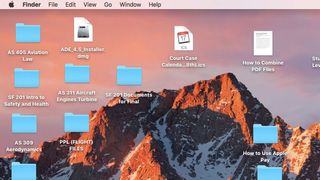
1) Navigate to the top of your laptop screen and click on the Apple logo .
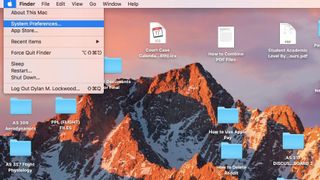
2) A dropdown menu will appear . Scroll down in the menu and click on the System Preferences tab.

3) Once in System Preferences, navigate to the bottom of your menu and click on the Parental Controls tab.
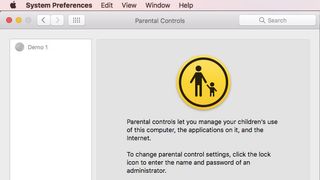
4) In the Parental Controls tab, select the account that you wish to make changes to by selecting the name on the right-hand side of the screen, as well as selecting the lock icon.
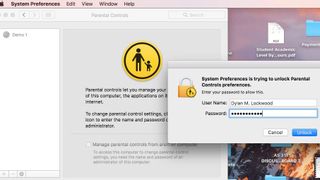
5) After selecting the lock icon, log into your computer’s administrator account and continue.
Stay in the know with Laptop Mag
Get our in-depth reviews, helpful tips, great deals, and the biggest news stories delivered to your inbox.
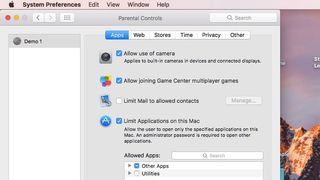
6) Next, select the account that you wish to make changes to on the left side of the screen. The account I will be accessing is called Demo 1.
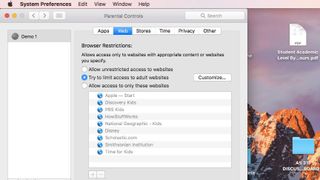
7) At the top of the task bar, navigate over to the Web tab. Click on the Web tab . While in the tab, click on Try to limit access to adult websites and from there hit Customize.
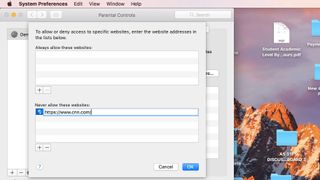
8) In the Customize tab , scroll down to the bottom of the screen, and click the + icon under the Never allow these websites tab. From there, you may add any website that you wish to be blocked, and the access to that website will be restricted.
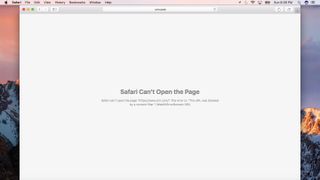
9) Log into the other account and attempt to view the blocked site. It should now be inaccessible.
How to convert PDF to JPG, PNG, or TIFF
How to add Outlook Calendar to Google Calendar
Save $500 on the latest Lenovo ThinkPad X1 Carbon with Intel Ultra CPU
Most Popular
- 2 Best laptop deals in April 2024
- 3 Fallout 4 gets a massive update — here's what's new on PC, PS5, and Xbox
- 4 Where is Windows 12 and can we expect it in 2024?
- 5 Razer Viper V3 Pro review: The new king of esports gaming mice

How to Block Websites in Safari Browser on your Mac, iPhone, and iPad
If you’re planning to block websites in Safari, and are new to the Apple Ecosystem, then you’re certain to get confused. Whether you’re blocking the website because of annoyance or for your children , the reason could be anything. Albeit, blocking websites on Safari, Chrome, Firefox, Edge or any other browser in Apple devices like Mac, iPhone, and iPad is as easy as pie.
There are multiple ways to block websites in Safari and it’s a little different on Mac, iPhone, and iPad but almost similar. In this guide, we’ll show you how to block any website on your Mac, iPhone, and iPad if you’re using the Safari or any other browser.
Guide to Block Sites on Safari on iPhone, MacBook and iPad
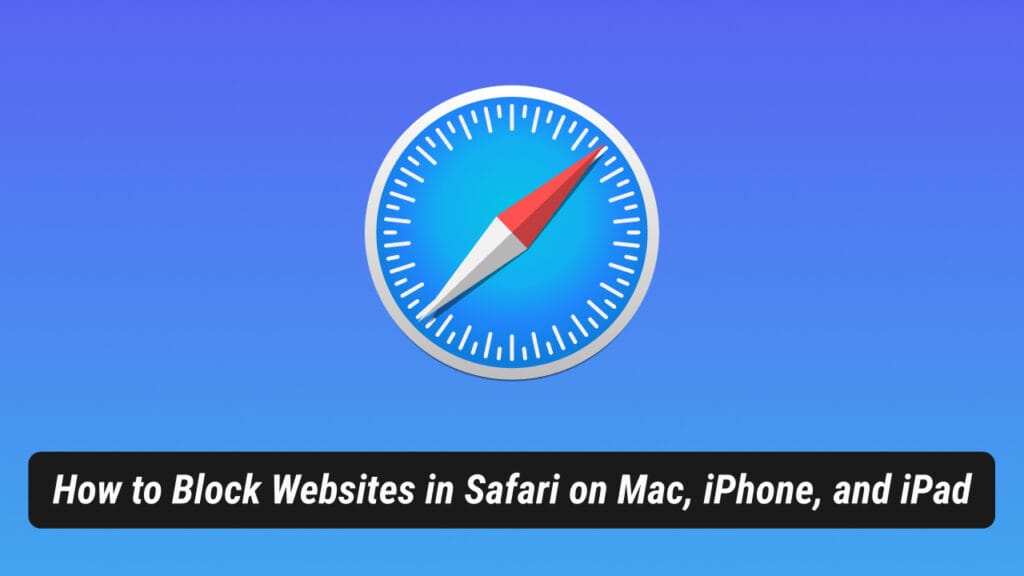
Safari is a great web browser when it comes to browsing. But when you’ve to block certain websites for your employees or kids, it could be a little difficult for new Apple device owners.
However, Apple provides a system-wide solution to block websites on your device entirely whether it is Mac, iPhone, or iPad.
The method involves using the Screen Time feature on macOS, iOS, and iPadOS to block multiple websites. You can either choose to block only adult websites or choose custom sites to block.
So here’s how to block websites in Safari or any other browser on Mac, iPhone, and iPad.
When blocking websites with Screen Time, it works system wide and your machine can’t access the blocked URL anywhere. Be it in web browser or any installed apps. It acts like a system-wide parental control.
Steps to Block Websites on Safari in macOS
The easiest way to block websites on Mac is by using the new Screen Time feature. The Screen Time feature on macOS was introduced with the launch of macOS Catalina.
For this method to work, you need to be running macOS Catalina (version 10.15) or above. If you haven’t updated your Mac yet, then you should update it to the latest version for it to work. Once you update your macOS to the latest version, then follow these steps to block sites in Safari on Mac.
- Click on the Apple logo on the top-left corner of your screen.

- Select Content & Privacy from the options on the left.
- If it is not turned on by default, then you can click on the Turn On button.
- Under Web Content , choose Limit Adult websites option to block well known adult sites automatically.

- Type the URL of the website to block or restrict from viewing in Safari.
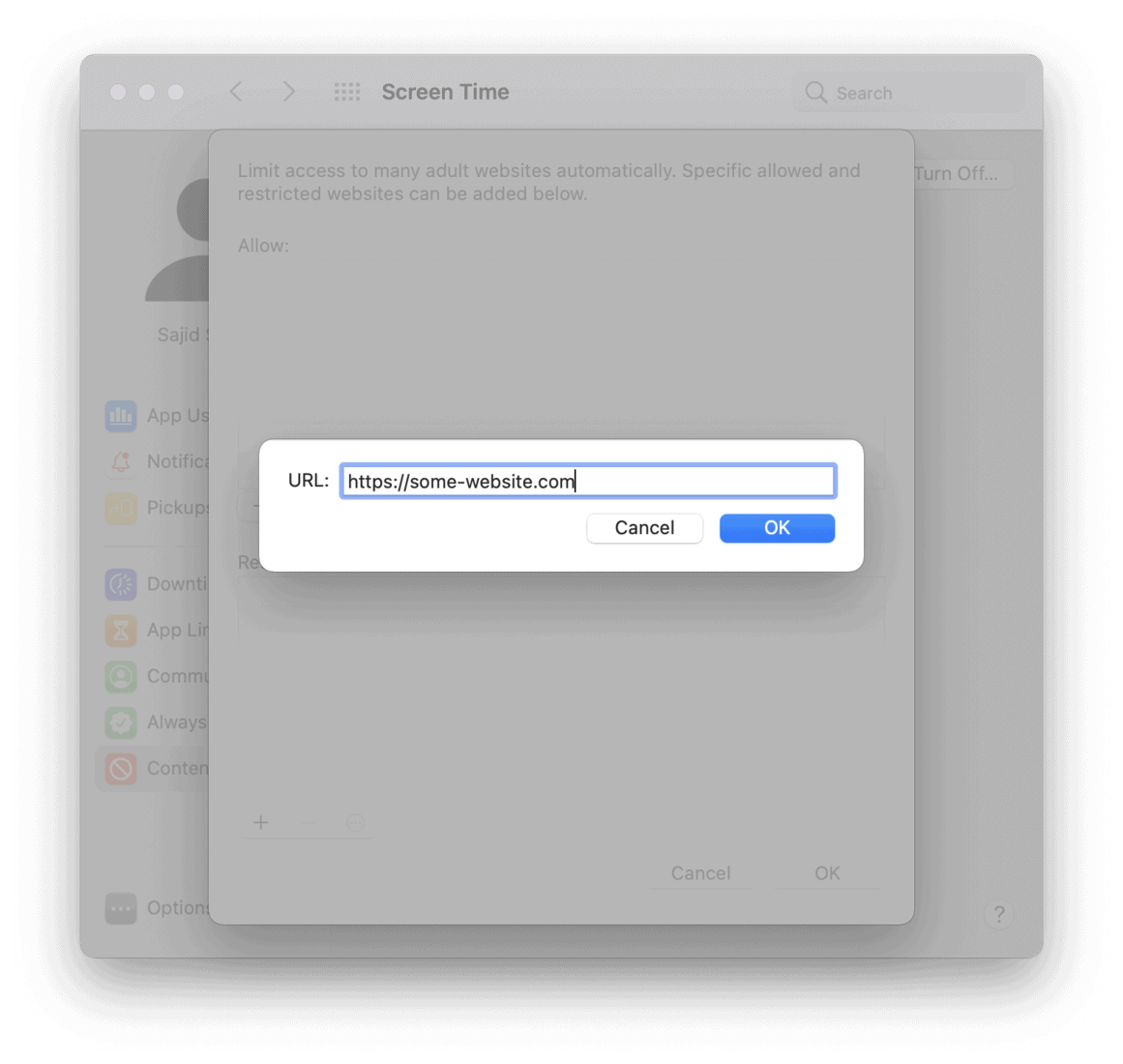
- Save the blocked list by clicking on OK
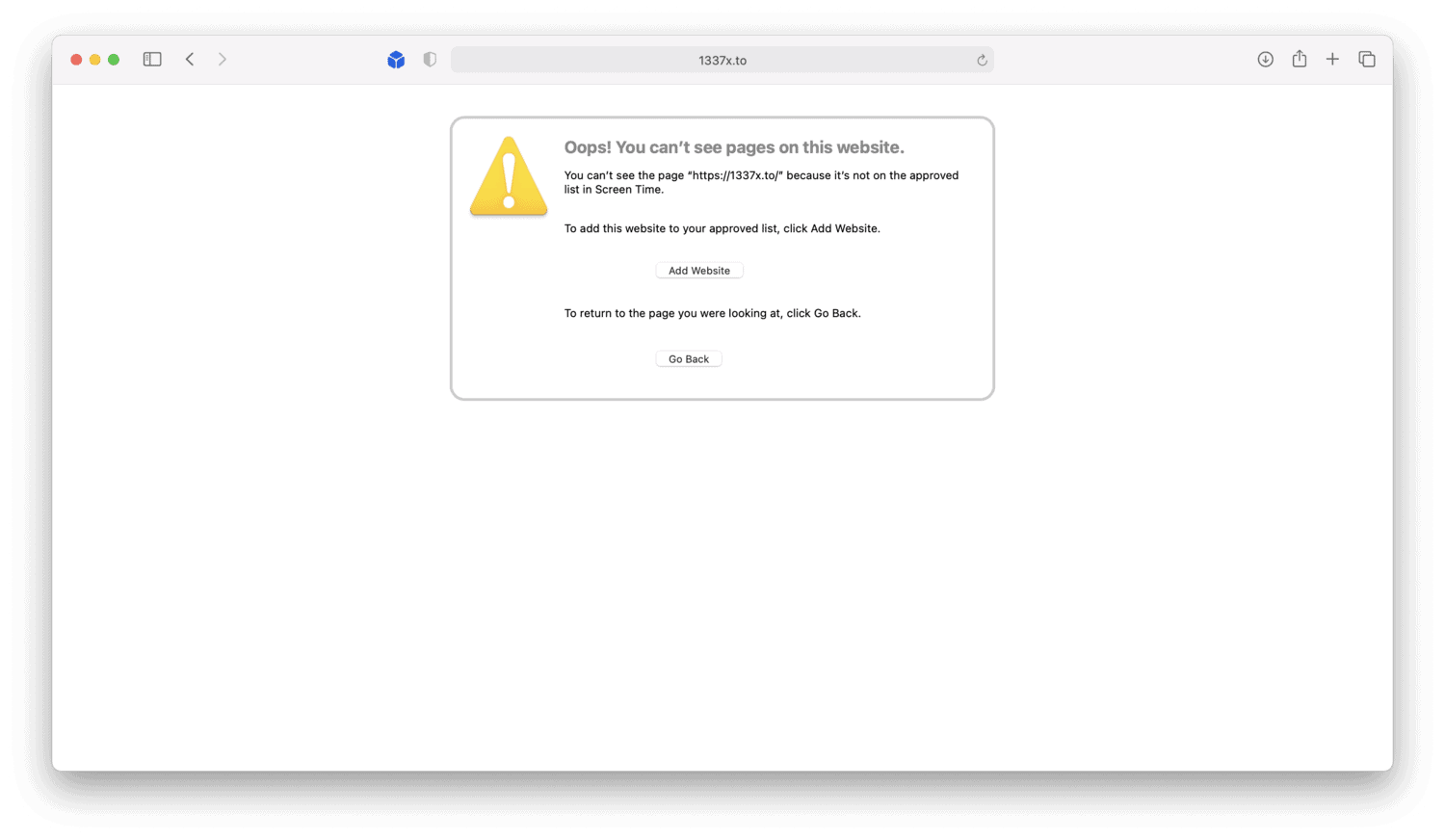
This is how you can block websites in Safari. On top of this, the websites are blocked on other browsers as well. Whether you use Google Chrome, Edge, Firefox, or any other browser, the restricted sites will not open on any of the browsers.
Also Read : How to Delete Apps on Mac That Won’t Delete
Furthermore, if any user knows how to unblock the blocked websites in Safari, then it’s best to use a passcode for Screen Time as well.
Also, the restriction popup contains an “Add Website” button which adds the website to whitelist but it requires the administrator password. Make sure the password is strong enough to guess.
Steps to Block Sites on iPhone and iPad
Blocking websites on iPhone and iPad are pretty similar to that of a Mac. However, you should be running iOS 13/iPadOS 13 or above to block websites on iPhone and iPad respectively.
If you aren’t running on iOS/iPadOS 13 or above, then you should update to the latest version. Once updated to the latest version of iOS and iPadOS, follow these steps to block websites in Safari on an iPhone and iPad.

- Now select Content Restriction .

- Under choose Never Allow , tap on Add Website to add custom sites.
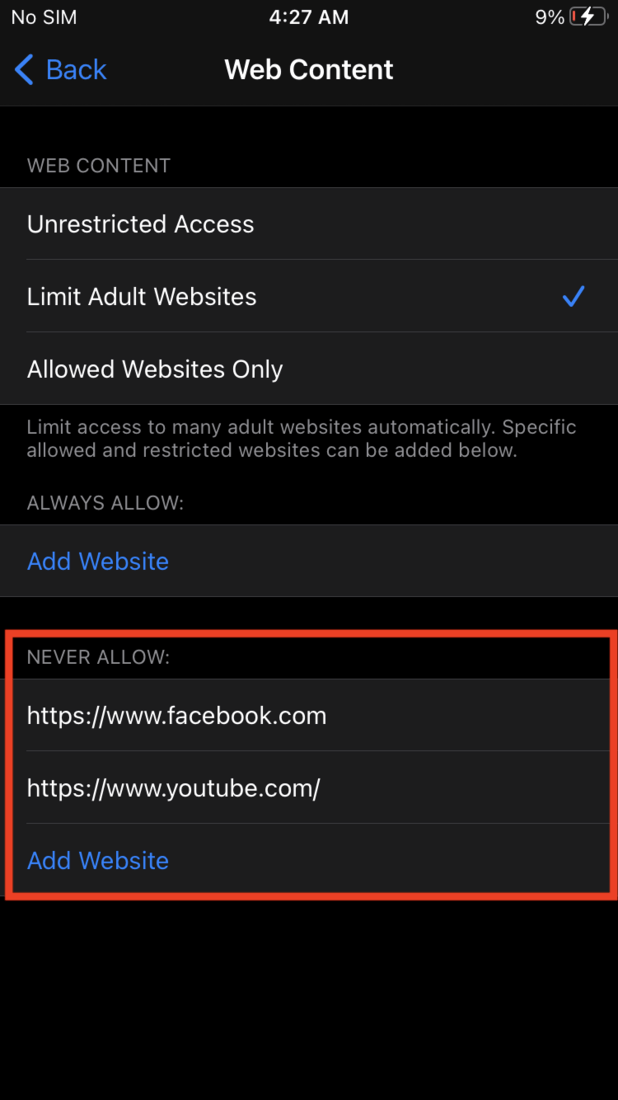
After adding the websites list, they will be blocked and you can’t open them on the iPhone or iPad anywhere including Safari browser. Using Screen Time is the best method to block websites in Safari on iPhone and iPad. Similar to macOS, the websites will be blocked on other browsers as well including Chrome and other browsers.
Also Read : 2 Ways To Enter and Exit Recovery Mode on Any iPhone
You can swipe left on the website URL, and tap on Delete to unblock the website whenever you want.
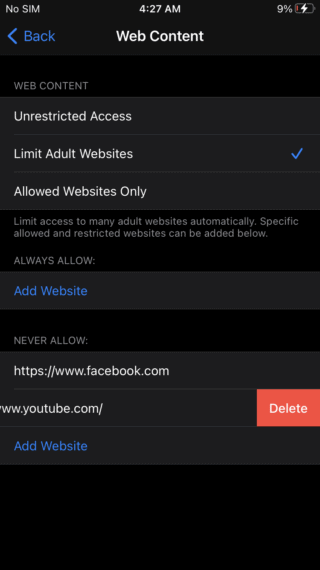
Block Websites System-wise on macOS, iOS and iPadOS
Whatever the reason may be for your blocking, you’ll be able to block any site on macOS, iOS, and iPadOS. However, make sure that you don’t let anyone access the Screen Time feature without any passcode. If they know how to get past the blocking, the blocking will be of no use.
In addition to blocking websites on Safari whether it’s Mac, iPhone, or iPad, it also blocks them at system-level blocking. Hence you can’t access those sites anywhere inside your device with any tool. I guess blocking sites on Safari isn’t hard as you think.
Hope this guide helped you in blocking websites in Safari without any parental control apps and modifying your router setting. If you have any queries or suggestions related to this topic, make sure to leave them in the comments.
Be the Change!
Spread the word and help us create better tech content
Sajid Shaik
A 22-year-old Tech Enthusiast who is into tech more than you. New tech excites him moreover anything else. Apart from tech, he does Graphic Designing as well. He's well known for his Vector Avatar made for MKBHD.
Leave a Reply Cancel reply
The comments section is to assist our readers with any inquiries. Each comment undergoes rigorous moderation before it can be approved for publication. Your name and comment will be publicly visible. Your email address will not be published. Required fields are marked *
Save my details (Name, Email, and Website) in browser and automatically add them when I visit next time.
By commenting on ths website, you agree to our Privacy Policy and Terms and Conditions *
- Dragon’s Dogma 2
- Genshin Impact
- Honkai Star Rail
- Lego Fortnite
- Stardew Valley
- NYT Strands
- NYT Connections
- Apple Watch
- Crunchyroll
- Prime Video
- Jujutsu Kaisen
- Demon Slayer
- Chainsaw Man
- Solo Leveling
- Beebom Gadgets
How to Block Websites in Safari on iPhone and Mac
How to Block Websites in Safari on iOS, iPadOS, and macOS (June 2021)
How to block websites in safari using screen time on iphone and ipad.
- Open the Settings app on your iPhone or iPad.
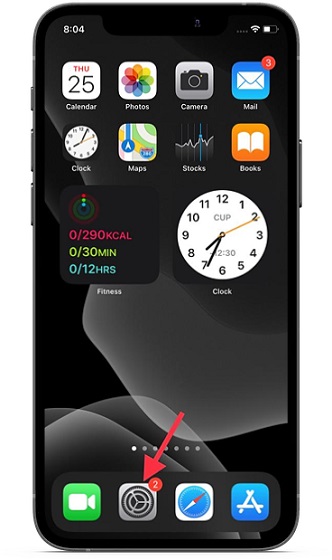
4. Next up, turn on the switch next to “ Content & Privacy Restrictions ” and tap on the “ Content Restrictions ” option.

Going forward, if someone tries to access the website through Safari, it will show you an “ Access Restricted ” error message. Besides, there will also be a warning saying, “You can’t browse this page at www.xyz.com because it’s restricted.”
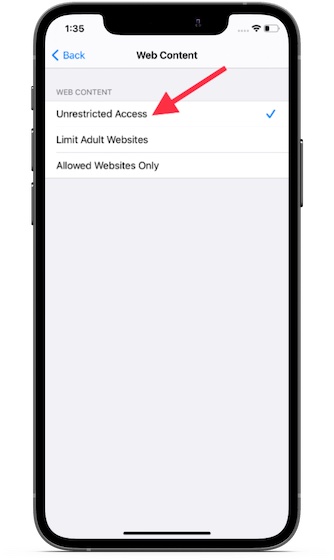
How to Block Websites in Safari Using Screen Time on Mac
- Launch “ System Preferences ” from the dock on your Mac. Alternately, click on the Apple icon at the top left corner and click on System Preferences from the drop-down menu.

2. Now, choose Screen Time.
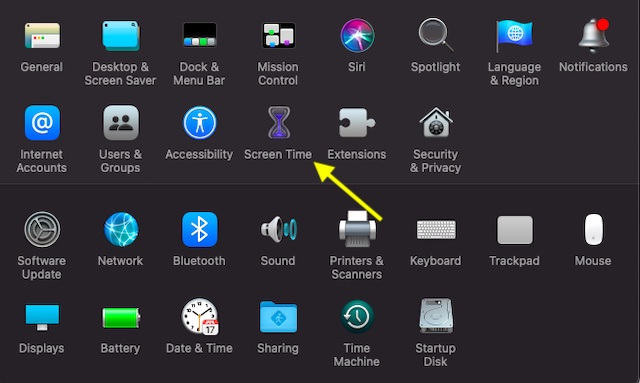
7. That’s it! Now onwards, Safari won’t open this website. Whenever someone tries to open any of the blocked websites, the browser will show a warning saying, “Oops! You can’t see pages on this website. You can’t see the page “https://www.xyz.com/” because it’s not on the approved list in Screen Time.”
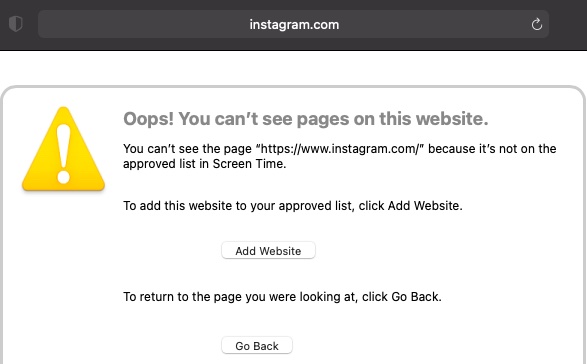
How to Block Websites in Safari Using AppCrypt on Mac
- First off, download Cisdem AppCrypt ( Free , in-app purchases available) on your Mac and set a password. Make sure to remember your AppCrypt password as you cannot reset or retrieve it in the future. Click on “Submit” once you are done.

3. Next, click the “+” button at the bottom left and add the URL of the website you want to block in Safari on your Mac. If you want to block all sites except a few, use the Allowlist feature.
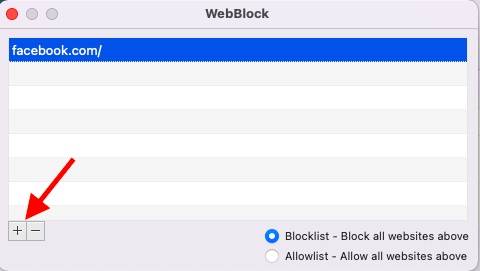
How to Block Websites in Safari Using a Third-Party App on iPhone and iPad
- Download the website blocker app ( Free ) on your iPhone or iPad. Then, launch the app and set a login password and log in.

Note : Ensure that the website blocker is enabled in Safari. Open Settings app -> Safari -> Content Blockers (in iOS 14) or Extensions (in iOS 15 or later) and then make sure that the toggle next to the website blocker app is turned on.
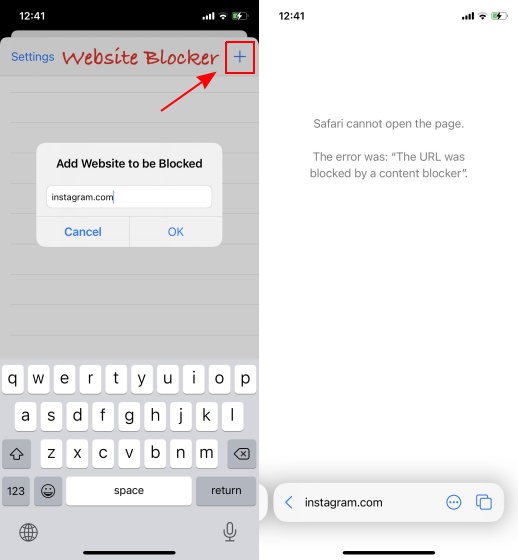
Block Websites in Safari with ease on iOS and macOS
Rajesh Mishra
An old school bibliophile who turned a tech nerd out of obsession. When he is not digging into hacks and tracking down stories that are breaking the internet, you may find him reciting poems.
Add new comment

How to block websites on iPhone and iPad
Learn how to block websites on iPhone and iPad, especially if you have children or come across content you'd rather unsee

If you're wondering how to block websites on iPhone and iPad then there's a strong chance you've come across a site that you'd rather not view again. Either that or you have children who you would like to keep safe online. After all, there's a lot of great content out there, but a helluva lot of bad stuff, too!
Stick with Safari as your browser of choice, however, and you can easily filter out unwanted websites. As well as blocking adult content, you can ensure specific sites cannot be accessed. You can also go the other way by making sure there's a blanket ban on all but a handful of websites. These are based on a list which you can tailor to suit your circumstances.
How to block websites on iPhone: Access the web content settings
In all cases, the website-blocking features are situated within Screen Time so, to make use of any one of the three functions explained below, you will need to follow these four steps first.
1. Launch the Settings app on your iPhone or iPad and tap Screen Time .
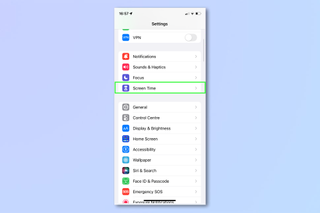
2. Select Turn On Screen Time if it's not already on and follow the on-screen instructions to get set up. Otherwise, tap Content & Privacy Restrictions .

3. Toggle the Content & Privacy Restrictions button into the “on” (green) position.
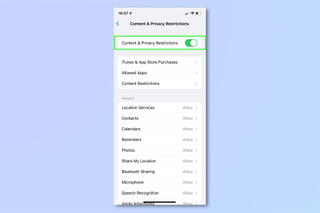
4. Tap Web Content .
Sign up to get the BEST of Tom’s Guide direct to your inbox.
Upgrade your life with a daily dose of the biggest tech news, lifestyle hacks and our curated analysis. Be the first to know about cutting-edge gadgets and the hottest deals.

How to block websites on iPhone: Limit adult websites in Safari
Now that you know how to get into the web content settings, you can start to block websites.
The simplest option is to make use of Apple's own list of adult websites. This will prevent you (or anyone else) from using Safari on an iPhone or iPad to view material aimed at adults.
1. Follow the steps above (concerning web content settings) and tap Limit Adult Websites .

2. If you find this limits some websites that you would like to remain viewable, tap Add Website under Always Allow.
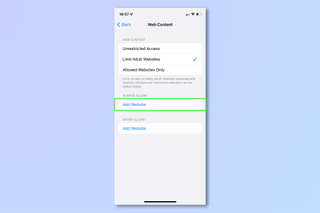
3. You can then type the URL of the site you want to see. Tap Done and tap Web Content to go back to the previous screen.

How to block specific websites on iPhone and iPad
You can also go further and select specific websites that you want to block. These will be in addition to the list of adult websites gathered by Apple.
1. Follow the steps above (concerning web content settings) then tap Limit Adult Websites .
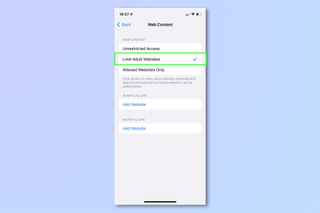
2. Now tap Add Website under Never Allow .
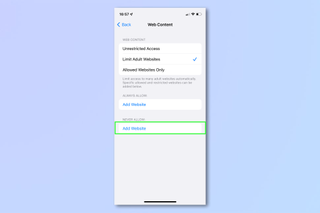
3. Type the URL of the site you do not want to view and tap Done . You can then tap Web Content to go back to the previous screen.
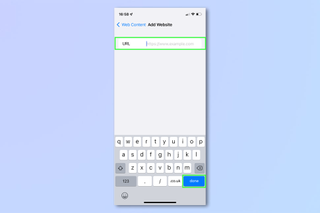
How to only allow specific websites to be viewed on iPhone and iPad
The third way of restricting access to online content is to block almost every website, before then allowing certain ones to be viewable.
1. Follow the steps above (concerning web content settings) and tap Allowed Websites Only .
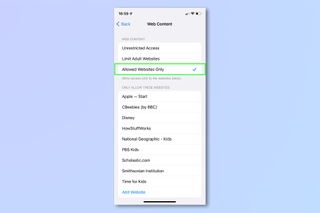
2. Now, underneath the list of websites which Apple will automatically allow, tap Add Website .
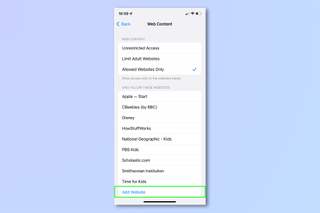
3. Enter the title of the website you want to allow and enter the website's URL . Tap Done and tap Web Content to go back to the previous screen.
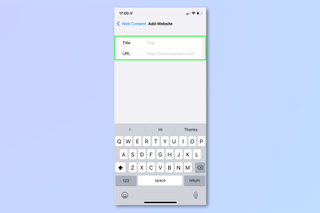
And that's it. You should now be able to work out which approach works best for you. If you want to use a different browser, check out how to block a website in Chrome . If you're worried about theft try how to disable control center on a locked iPhone . You can also say goodbye to irritating ads thanks to the best ad blockers , learn how to disable the pop-up blocker in your browser , and, for good measure, figure out how to block spam calls on iPhone . If you're thinking about upgrading your Apple tablet, make sure you read our guide on how to transfer data from iPad to iPad . And if you're like to learn more about using your smartphone's apps, start with how to change your Instagram username .

David Crookes is a freelance writer, reporter, editor and author. He has written for technology and gaming magazines including Retro Gamer, Web User, Micro Mart, MagPi, Android, iCreate, Total PC Gaming, T3 and Macworld. He has also covered crime, history, politics, education, health, sport, film, music and more, and been a producer for BBC Radio 5 Live.
Google Maps on iPhone may finally get this useful navigation feature
I’ve used the iPhone 15 Pro for 6 months — 6 camera upgrades that the iPhone 16 Pro needs
One of the best thrillers you haven’t watched yet just crashed the Netflix top 10
Most Popular
- 2 Google Pixel Tablet tipped to ditch the dock and finally get a productivity boost — stepping up to iPad Air
- 3 This romantic comedy has taken the No.1 spot on Netflix — and it deserves to be there
- 4 Huge TV sale at Amazon and Best Buy — 13 deals I'd buy with up to 40% off
- 5 Hoka launches carbon plated running shoes that you can't actually race in — here's what you need to know
How to block websites and set content restrictions on an iPhone or iPad
- To block websites on an iPhone or iPad, go to the "Content Restriction" section of Screen Time.
- You can block all adult sites or limit access to a list of pre-approved websites.
- You can also block websites with explicit language and protect the settings with a passcode.
With the full swing of the digital age, it's not uncommon to have children under the age of 12 with an iPhone or iPad.
If you want to set up an iPhone and iPad for your child, you may consider restricting access to any websites that you'd rather not end up in front of young eyes.
Here's what you need to know to block websites on an iPhone or iPad.
How to block websites on an iPhone and iPad
There are various ways you can block websites on an iPhone so your child doesn't visit them.
1. Open the Settings app.
2. Scroll down and tap Screen Time .
3. Tap Content & Privacy Restrictions .
4. Tap the toggle for Content & Privacy Restrictions to switch it to the right (a green background will appear around the switch).
5. Tap Content Restrictions .
6. Tap Web Content .
7. Choose how you want to limit web access.
- Limit Adult Websites: This option blocks sites known to be adult in nature (like nudity and pornography). You can also add more sites that will always be blocked or allowed.
- Allowed Websites Only: This option allows you to create a customized list of the only sites that will be allowed.
How to block searches and explicit language on an iPhone and iPad
You should also consider blocking websites that contain explicit language.
1 . Open the Settings app.
2 . Scroll down and tap Screen Time .
3 . Tap Content & Privacy Restrictions .
4 . Tap Content Restrictions .
5 . Tap Explicit Language .
6 . Tap Don't Allow .
How to set up a passcode to protect your content restrictions
While you're at it, you should also set up a screen time passcode. This will prevent any semi-savvy child from undoing any of the settings he or she doesn't like.
3 . Tap Use Screen Time Passcode .
4 . Enter and re-enter the passcode.
5 . Enter your Apple ID username and password so you can recover the passcode if you forget it and tap OK in the bottom right corner of the pop-up.
Now whenever anyone tries to change the Screen Time settings they'll have to enter the passcode to get through.
- Main content
- Editorial Process
- Why Trust Us?
- Affiliate Linking Policy
- Privacy Policy
- Terms of Service
Weekly Must-Reads View All
7 things to do if you spilled water on your macbook.
Quick steps to save your MacBook from water damage
How to Boot Your Mac Into Verbose Mode: 4 Best Ways
Boot your Mac into Verbose Mode with this step-by-step guide
How to Fix Your Mac Shutting Down Randomly: 16 Fixes to Try
Troubleshoot random shutdowns on Mac with effective solutions
How Much Space Does macOS Take On Your Mac?
Understand macOS size and analyze your Mac's storage usage
Popular Topics
- What to Do With Your Old MacBook? 13 Useful Ways to Reuse an Old Mac
- What Is the MacBook Flexgate Issue and How to Fix It
- What Is the MacBook Flexgate Issue
- Uninstall Java
- Safely Transfer Files from Mac to Mac
- Safari Bookmarks Disappeared on Mac: 10 Best Ways to Restore Them
- Repairing disk permissions
- Old MacBook
Trending Now View All

- Mac Maintenance
How to Block Websites on Safari on Mac: 5 Best Ways
Hashir Ibrahim
Reviewed by
Last updated: December 22, 2023
Expert verified
To block websites on Safari on a Mac, use one of the following methods:
- Set up Screen Time in System Settings and choose Content & Privacy to limit adult websites or specify only allowed websites .
- Access your router’s settings via its IP address and use the Access Restrictions or Parental Controls to block specific websites.
- Install a web blocker extension from the App Store.
- Download and use third-party web blocker apps.
- Use the sudo nano /etc/hosts command to edit the host file via Terminal to block specific websites.
I know how easy it is to get distracted online, especially when trying to work or study on a Mac. That’s why I put together this guide with simple, straight-to-the-point steps that I use myself to keep focused. These methods really work whether you’re aiming to stay focused, manage your online activities, or just streamline your browsing.
Before We Begin
Besides blocking websites on your Mac, you should also remove adware and unwanted programs. Download MacKeeper and use its Adware Cleaner to avoid annoying pop-ups that send you to websites you don’t want to visit.
How to Block a Website on Safari on Mac
There are different solutions for blocking websites on Safari. Below, I’ve shared some quick ways to block websites on Safari.
1. Use Screen Time
Screen Time is a feature in macOS, iOS, and iPadOS that allows you to set limits on app usage, including Safari. You can use Screen Time to block specific websites or categories of websites during certain times of the day. You can also use it to block all websites and whitelist some specific ones.
For macOS 10.15 Catalina or Later
Here’s how to use Screen Time to block websites on Safari on your Mac:
- Open the Apple menu and click System Settings .
- Click Screen Time in System Settings and select Content & Privacy .
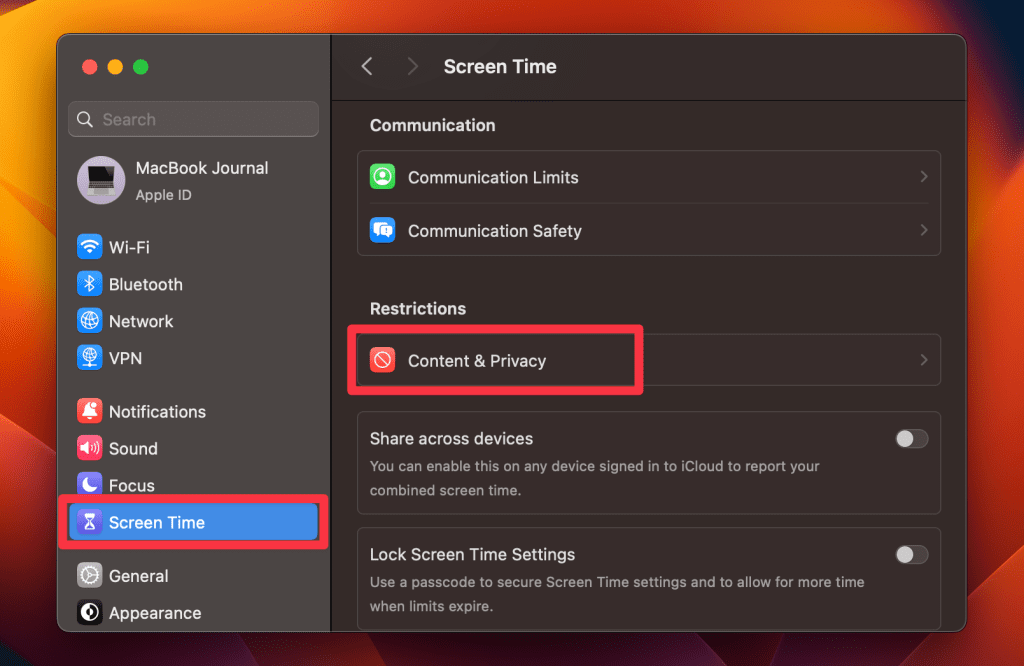
- Click Content Restrictions .

- A new window will appear. Click the drop-down icon next to Access to Web Content and select Limit Adult Websites .
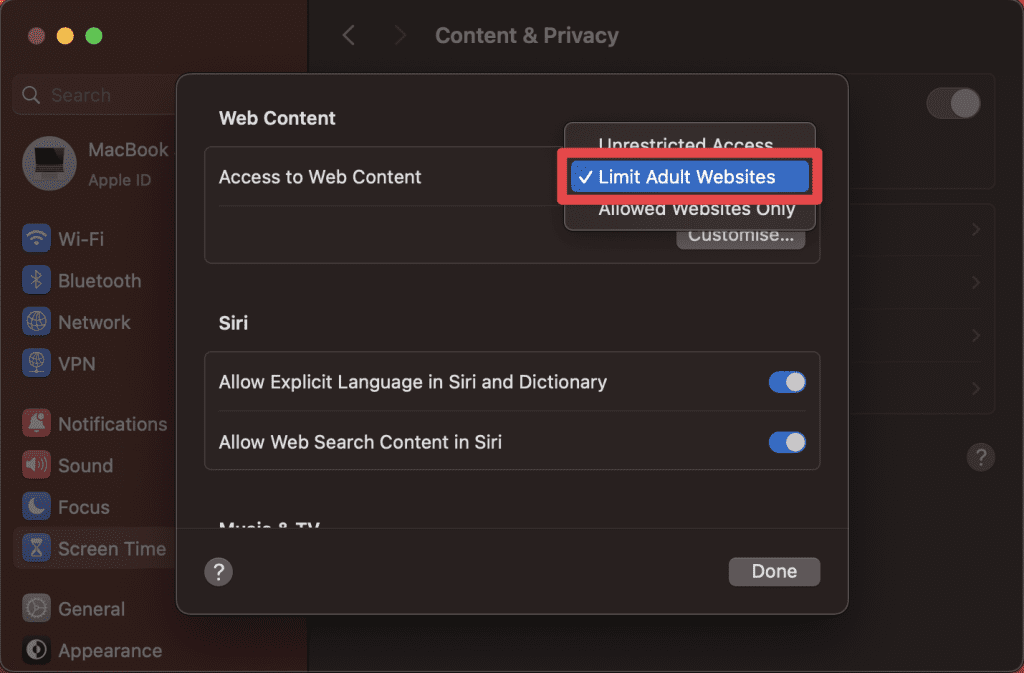
If you want to manage your time on specific websites using Safari, you can do that with Screen Time. Here are the steps for setting a time limit for certain websites on Safari on a Mac:
- Click Screen Time in System Settings and select App Limits .

- In the App Limits section, toggle on the App Limits switch and click the Add Limit button to create a new restriction.
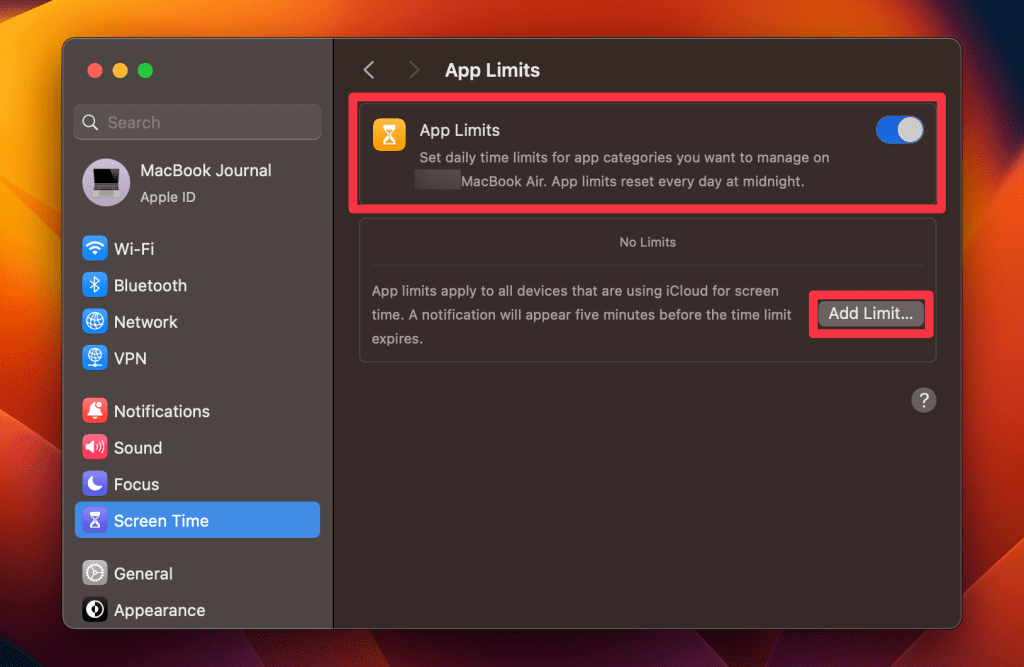
- Scroll down to the end of the list until you find the option for Websites .
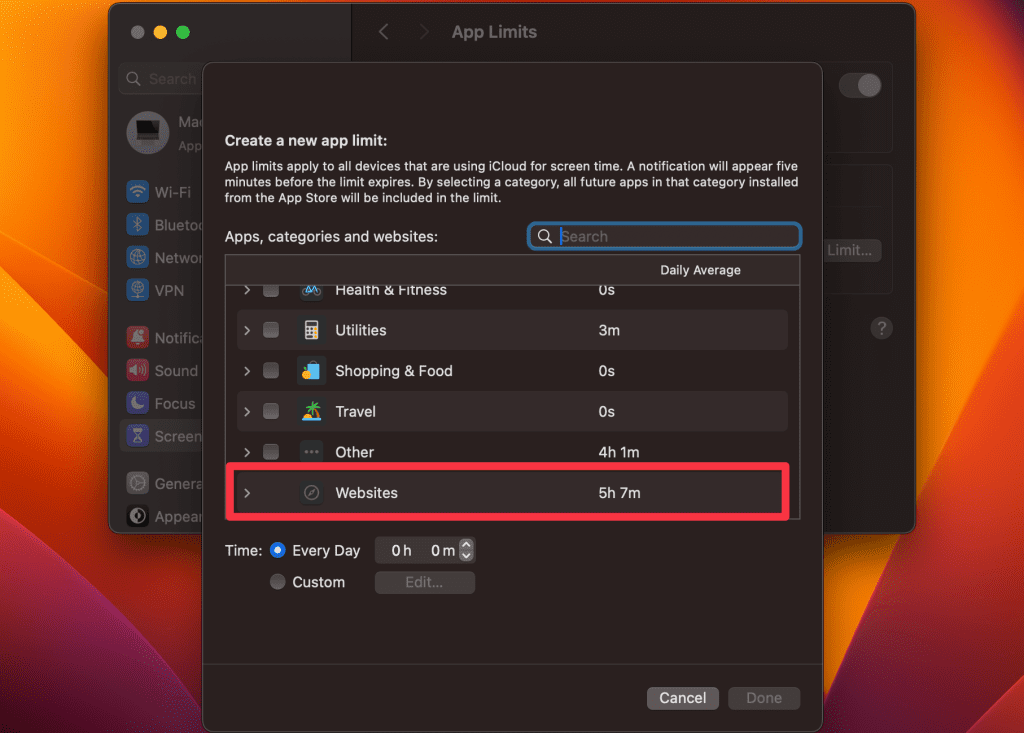
- Click the dropdown arrow next to Websites to specify which websites you want to set time limits for.
- Select a website from the list or add a URL.
- In the Time section, specify the time you wish to allow for this site. This is the duration for which you can access the site each day.
- Once you have set the time limit, click Done .
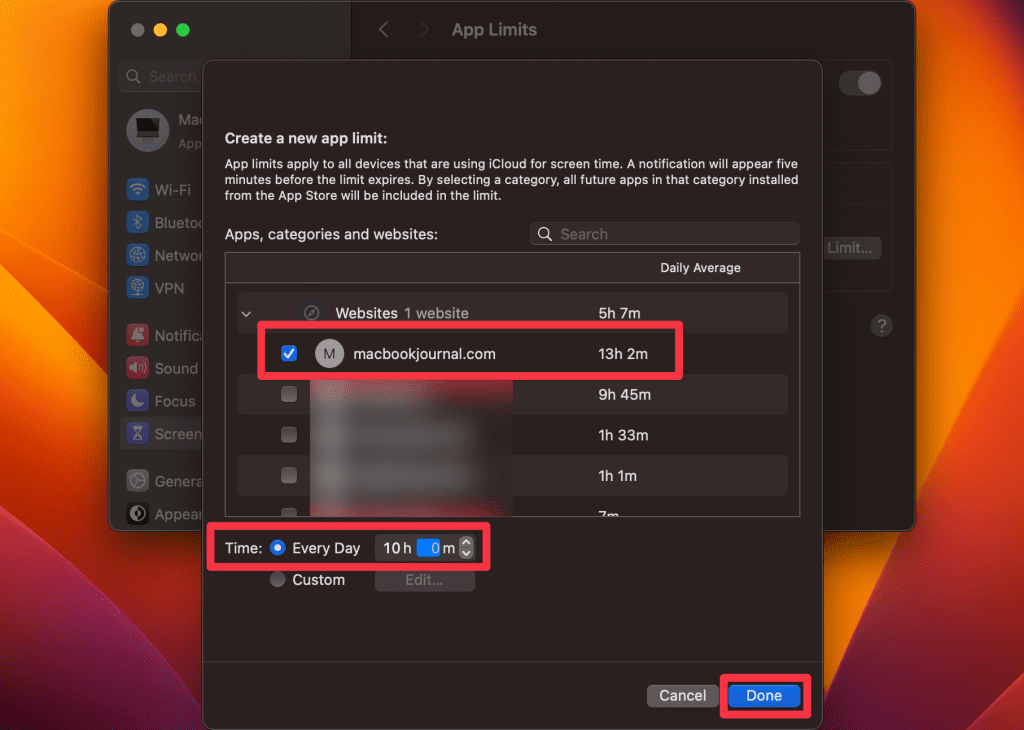
For iOS 12 or Later and iPadOS
Here’s how to use Screen Time to block websites on Safari on your iPhone or iPad:
- Open the Settings app on your iPhone.
- Tap Screen Time .
- If Screen Time isn’t already enabled, tap Turn On Screen Time , then tap Continue . If it’s for your iPhone, select This is My iPhone .
- Tap Content & Privacy Restrictions and toggle on the Content & Privacy Restrictions switch.
- Tap Content Restrictions and select Web Content .
- Select Limit Adult Websites .
- Tap Add Website in the Never Allow section.
- Type the website URL you want to restrict in the URL field and tap Done .
2. Change Router Settings
If you block websites through your router settings, it stops those sites on every device using your Wi-Fi. You just need to go into your router’s settings and choose the websites you want to block.
Here are the steps to block websites on Safari using router settings:
- Open your web browser and enter your router’s IP address in the address bar. You can usually find this information on the back of your router or in the manual.
- Enter your login credentials when prompted. The default username and password should be listed in your router’s manual if you need to change them.
- Look for the Access Restrictions or Parental Controls section in your router’s settings. It may be under the Advanced or Security tab.
- Choose the Website Blocking or Block Sites option.
- Enter the URL you want to block in the Website URL field. Some routers may also allow you to block websites based on keywords.
- Save the settings and exit the router’s interface.
3. Install A Web Blocker Extension
You can also add a browser extension to your web browser to do different things, including blocking websites. Safari doesn’t have a dedicated store for extensions, like Chrome. Instead, you have to download them from the App Store.
For Safari, I recommend a website-blocking extension called StayFree, a popular choice among Mac users.
For macOS 10.12 or Later
- Open Safari on your Mac.
- Click Safari in the menu bar and select Safari Extensions . This will open the App Store.
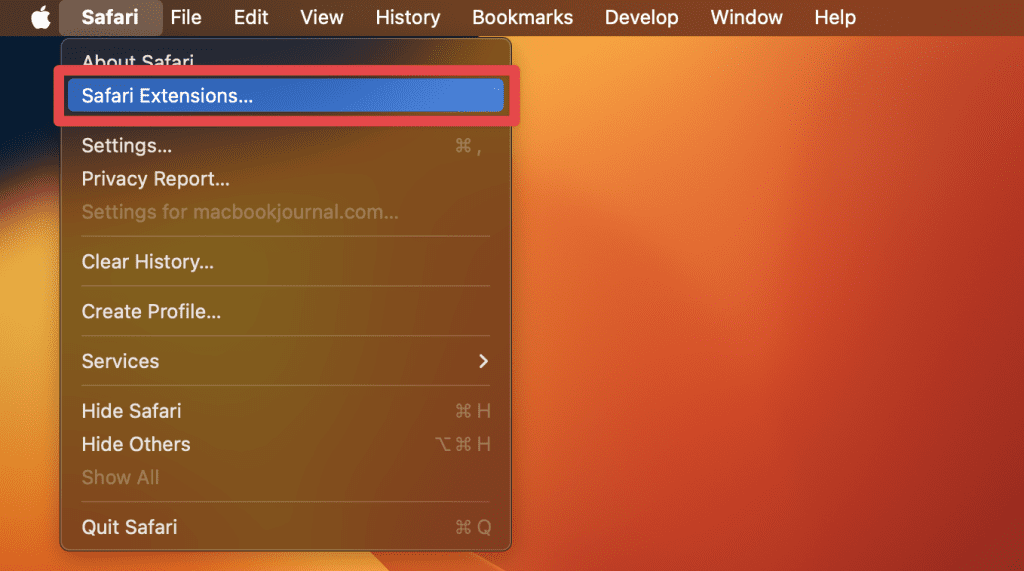
- In the App Store, type StayFree in the search bar and click Get > Install next to the app name in the results.

- Wait for the extension to install. Once it’s installed, you might get this notification in Safari. Click the Turn On Extensions button.

- Close Safari and reopen it. You should now see the extension’s icon near the address bar.
- To block a site, click the extension icon, and select Focus Mode Settings .
- It will open a new window. Click the Add Website button.
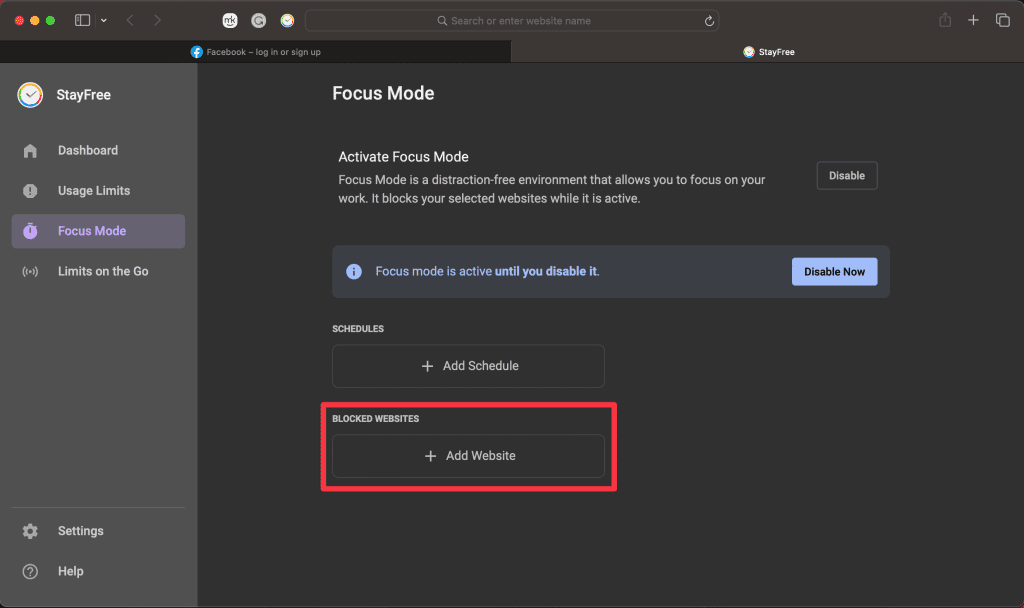
- Type the website URL and click Save . It will block the website and you won’t be able to reload it until you remove it from the Blocked Website list.
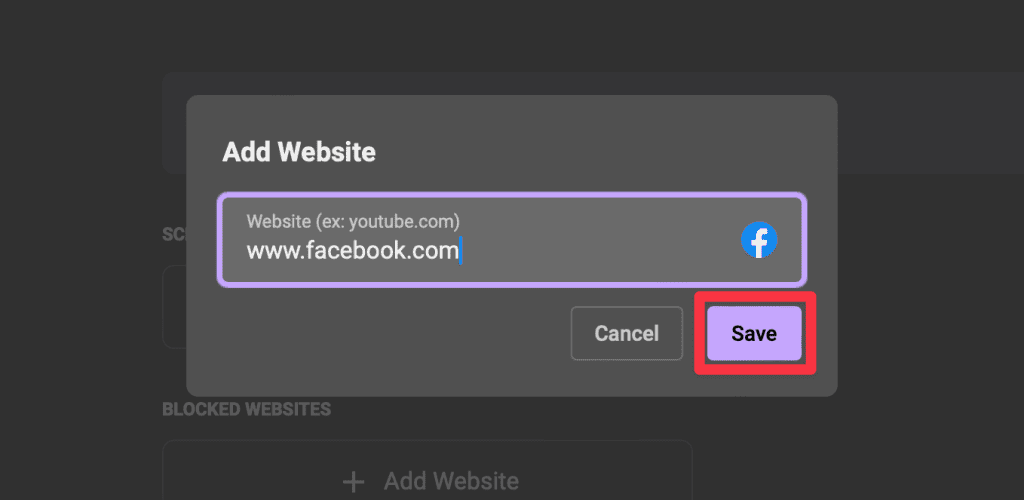
For iOS 15 or Later and iPadOS 15 or Later
iOS 15 and iPadOS 15 support web extensions for Safari. To add a Safari website blocker extension to your iPhone or iPad, follow these steps:
- Open Settings on your iPhone or iPad.
- Navigate to Safari .
- Select Extensions > More Extensions . This directs you to the App Store, showing compatible Safari extensions.
- Pick a web blocker extension for screen time control, and download it.
- Activate the Safari extension by going to Settings > Safari > Extensions .
- Find the web blocker extension you’ve installed and turn it on.
4. Use Third-Party Web Blocker Apps
Third-party web blocker apps offer another effective solution for managing online content access on Mac. These apps work by letting you make a list of websites you want to block. This stops you from accessing these sites for certain times you choose or all the time.
Here are some third-party web blocker apps that you might consider using:
- Cisdem AppCrypt : Cisdem AppCrypt is not just a website blocker, it also locks apps with a password. For website blocking, you can create a blacklist or whitelist and set up a schedule to block sites during certain times.
- 1Focus : 1Focus lets you block distracting websites and apps. It’s simple to use and lets you set periods of focus during which specific sites and apps are inaccessible. You can also schedule recurring focus sessions, making it a handy tool for establishing a routine.
- Freedom : Freedom is a popular app for blocking distracting websites and apps across multiple devices. It lets you create blocklists and schedule distraction-free sessions, making it a great tool for improving focus and productivity.
- SelfControl : Specifically for macOS, SelfControl lets you block access to distracting websites, mail servers, or anything else on the Internet. Once you set a period to block for, not even restarting your Mac or deleting the app will disable the block.
5. Map Domain Using Host Files/Terminal
Blocking websites in Safari on your Mac can be done by using host files. These files connect website names to their internet addresses. You can change these files to stop your Mac from reaching certain websites.
Here are the steps to map domain using host files:
- Open the Terminal application on your Mac. You can do this by searching for Terminal using Spotlight or by navigating to Applications > Utilities > Terminal .

- In the Terminal window, type the following command to open the host’s file and press Enter :
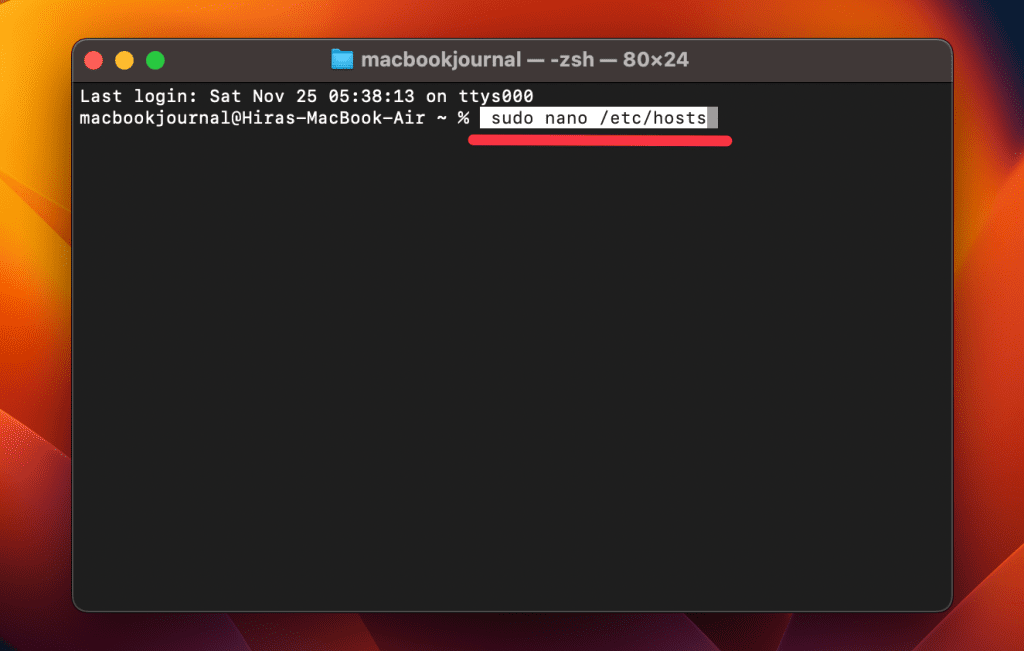
- You will be prompted to enter your admin password. Enter it.
- Use the arrow keys to navigate to the bottom of the host’s file.
- To block a website, add the following line to the bottom of the file, replacing example.com with the URL of the website you want to block:
- You can add as many websites as you want by creating a new line for each website.
- Press Control ^ + O to save the changes to the host’s file.
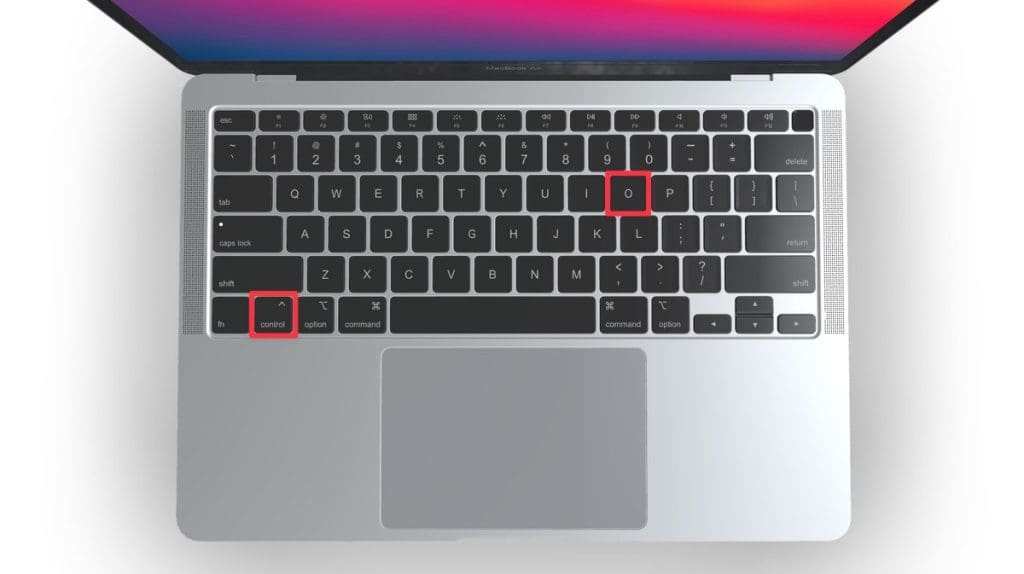
- Press Control ^ + X to exit the editor.

- To make the changes take effect, flush the DNS cache on Mac by typing the following command in the Terminal:

- It will clear the cached DNS entries, forcing the Mac to use the updated host file.
Once you’ve completed these steps, Safari and other browsers on your Mac should no longer be able to access the websites you’ve blocked in the host file.
This method blocks the websites system-wide, so it will affect all users on your Mac. To unblock a website, remove the corresponding line from the host file and flush the DNS cache again.
How to Whitelist Specific Websites on Mac
Once you’ve set up Screen Time to limit websites, most adult websites will become inaccessible. But if you want to allow specific websites only, follow these steps:
- Follow the above steps from 1 to 3, and instead of Limit Adult Websites, select Allowed Websites Only in the Web Content window.
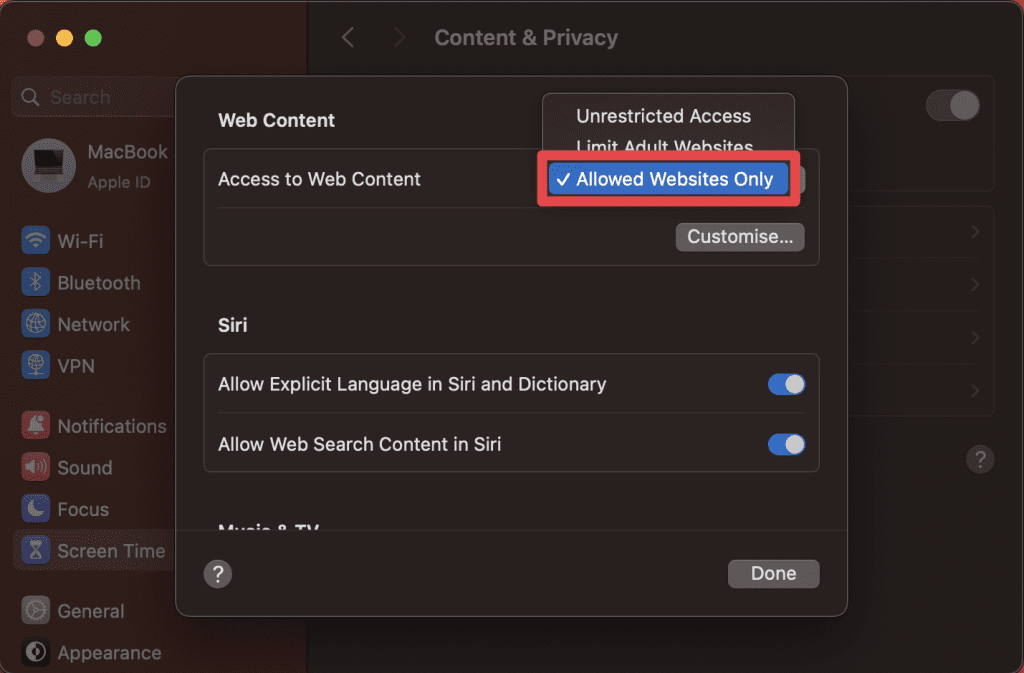
- Click the Customise button that appears.
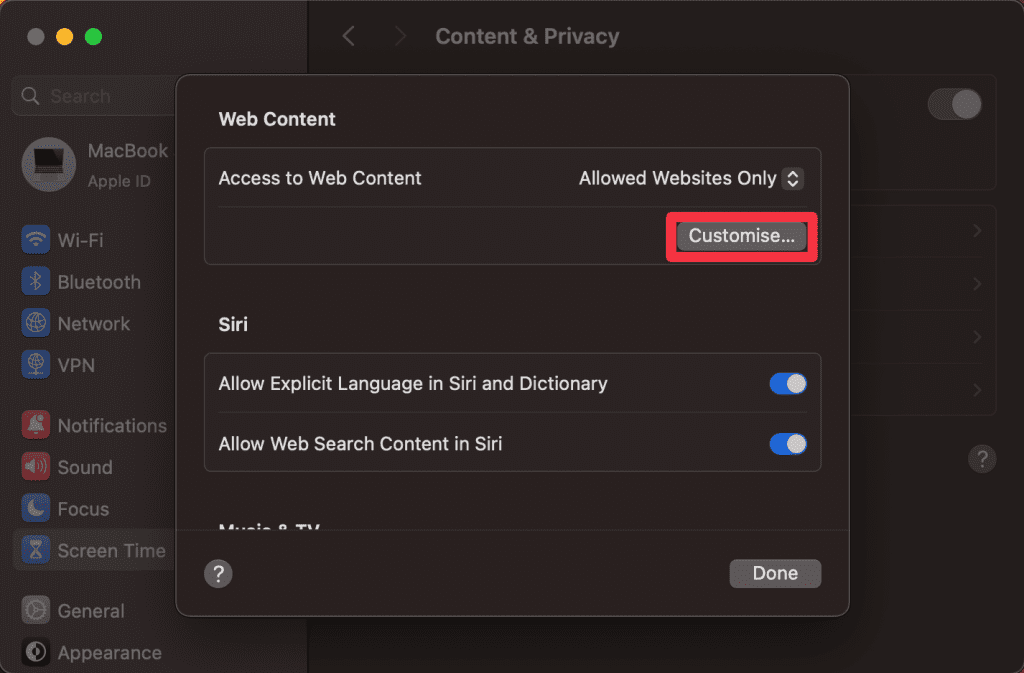
- In the new window, click the + button in the bottom left corner.
- Type in the name and URL of the website you want to allow and tap Done .
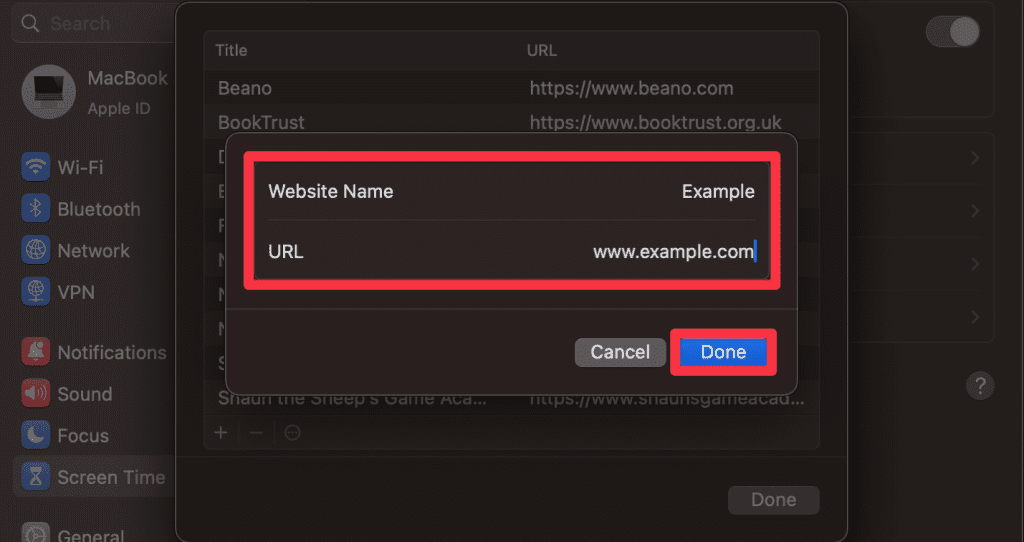
- The website you add will appear in the list.

- Click Done to close the window.
Avoid Distractions While Browsing With MacKeeper
MacKeeper does not offer a feature to block websites on Safari. But it offers an Adware Cleaner that can detect and remove adware and potentially unwanted programs causing unwanted pop-ups or redirects to certain websites. This can indirectly help with blocking certain websites.
To use the Adware Cleaner feature in MacKeeper:
- Download and install MacKeeper on your Mac.
- Open MacKeeper and click Adware Cleaner in the left sidebar.
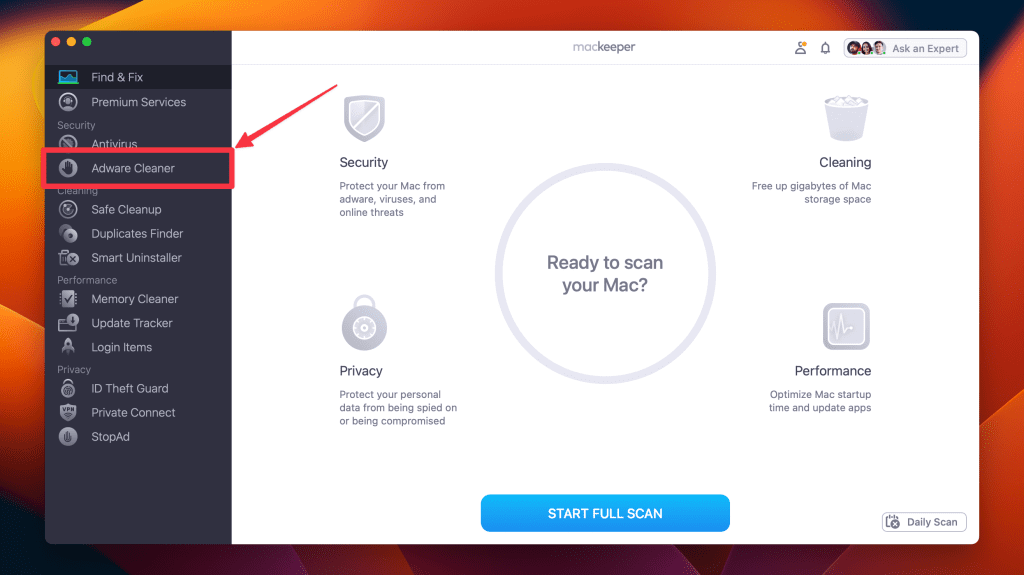
- Click Open .
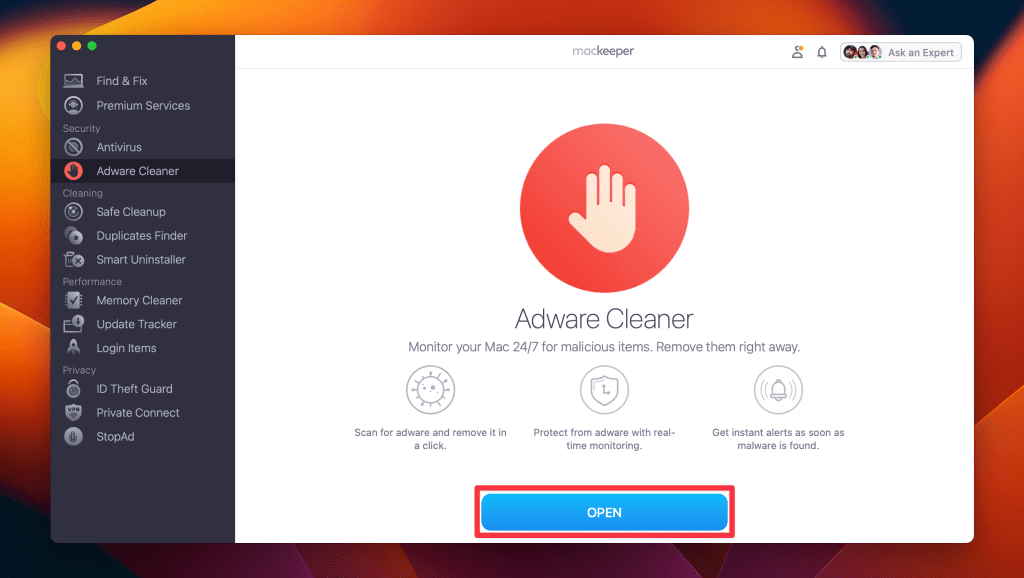
- Click Start Scan to scan your system for adware and potentially unwanted programs.
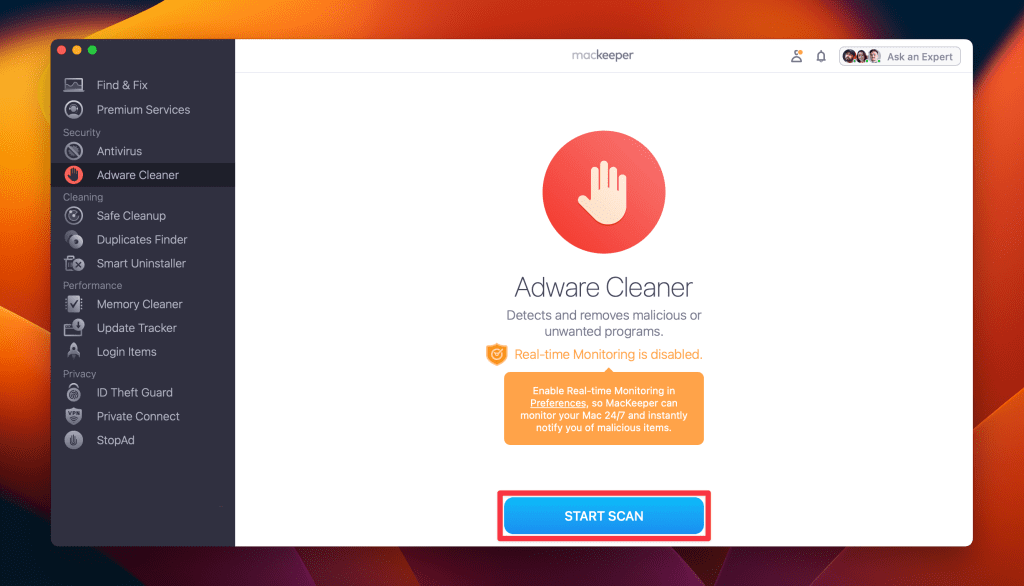
- Once the scan is complete, review the list of detected items and select the ones you want to remove.
- If there are no malicious files, you’ll get a No items found message on your screen. Click Rescan to run the scan again or close the program.
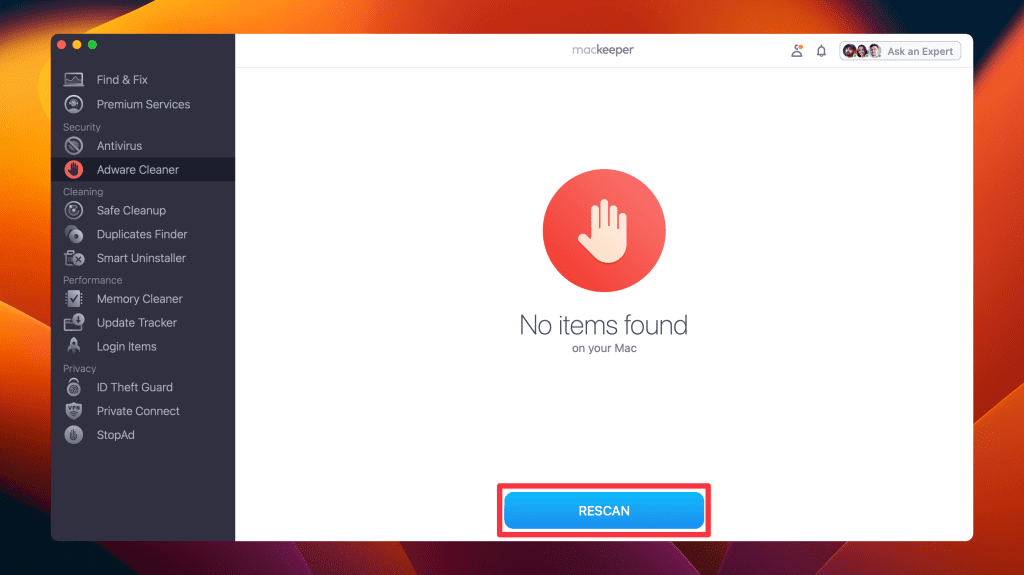
While this may not directly block websites on Safari, removing adware and potentially unwanted programs can prevent unwanted pop-ups or redirects to those websites. So, it’s worth a try.
What Else Can MacKeeper Do?
Besides removing adware on your Mac, MacKeeper can block ads on your Mac , disable pop-ups on Safari and other browsers, and remove browser extensions . Check out my MacKeeper review to learn about these features.
Why Would You Need to Block Websites on Safari?
Blocking websites on Safari can be necessary for several reasons:
- 🎯 Focus and Productivity : If you find yourself frequently distracted by certain websites while working or studying, blocking them can help maintain focus and boost productivity.
- 👪 Parental Controls : For parents, blocking websites is a way to ensure children don’t access inappropriate content or spend too much time on entertainment sites.
- 🔒 Online Safety : Blocking websites that are known for phishing, scams, or malicious content helps protect your personal information and your device’s security.
- 📶 Bandwidth Management : In some cases, especially in a workplace, blocking websites that consume a lot of bandwidth (like streaming services) can help maintain network performance.
- 💆 Digital Well-being : Sometimes, blocking websites can be a part of a digital detox strategy, helping reduce time spent on addictive sites and improving overall well-being.
In each case, the goal is to create a safer, more focused, and more productive online environment.
Block Unwanted Websites on Safari and Be More Productive
Now that you know how to block websites on Safari, you may want to take your productivity up a notch. Here are some more tips to make your Safari experience better.
- Clear Safari cache on your Mac to improve its performance and prevent slow loading times.
- If your Safari is crashing on Mac , troubleshoot the problem by updating it and clearing the cache and cookies.
- Update Safari on Mac to prevent crashes and improve its security.
Frequently Asked Questions
Can i unblock websites that i’ve blocked on safari on mac.
Yes, you can unblock websites previously blocked in Safari on your Mac. The method to unblock depends on how you blocked the site initially, whether through browser settings, a parental control app, or system files.
Can I password-protect the blocked websites?
No, you cannot password-protect the blocked websites using the built-in website-blocking feature on Safari. If you want to password-protect your blocked websites, use a third-party app or software that offers this feature.
Will blocking websites on Safari prevent me from accessing them on other devices?
No, blocking websites on Safari will not prevent you from accessing them on other devices. Blocking websites on Safari only affects your Safari browser on the device you set it up on. You can access those websites easily on other devices.
Can I block websites based on specific keywords?
No, you cannot block websites based on specific keywords using the built-in website blocking feature on Safari. However, some third-party apps or browser extensions allow blocking websites based on keywords or phrases.
I'm Hashir, a tech journalist with a decade of experience. My work has been featured in some of the top tech publications like MakeUseOf and MakeTechEasier. I have a bachelor's degree in IT, a master's in cybersecurity, and extensive knowledge of Apple hardware, specifically MacBooks. As the senior writer at MacBook Journal, I write in depth guides that help you solve any issues you have with your mac and unbiased reviews that help you make the right buying decisions.
Hi there! I'm Ojash, a tech journalist with over a decade of experience in the industry. I've had the privilege of contributing to some of the world's largest tech publications, making my mark as a respected Mac expert. My passion lies in exploring, using, and writing about MacBooks, and I enjoy sharing my expertise to help others make informed decisions and get the most out of their MacBook experience. Join me as we delve into the fascinating world of MacBooks together!
You May Also Like

How to Delete Downloads on Mac to Free Up Space Quickly
Quickly clear downloads on Mac for more storage space

How to Reinstall macOS on Your MacBook Air/Pro or iMac: 3 Best Ways
Reinstall macOS seamlessly on your MacBook Air, Pro, or iMac

How to Remove Login Items on Your Mac: 5 Quick Ways
Remove login items on your Mac to declutter startup programs

How to Delete Files on a Mac: 12 Best Ways
Written by Hashir Ibrahim Reviewed by Ojash Last updated: October 17, 2023
How to block websites on iPhone and iPad — keep your kids safe in iOS 17
Here's how to block websites on iPhone.

- Limit adult content in Safari
- Block specific websites in Safari
- Block everything except specific sites in Safari
Want to know how to block websites on iPhone and iPad? Apple offers the ability to do so on both iOS and iPadOS, allowing you to take control of Safari and restrict access to adult content such as porn and gambling.
This guide will teach you the three ways to block websites on iPhone and iPad by simply banning all adult content, adding specific websites to a ban list, or banning all websites and only allowing your children to access some.
This comprehensive how-to guide will show you everything you need to know and teach you how to block websites on iPhone and iPad in Safari on iOS 17 .
How to limit adult content in Safari for iPhone and iPad
The first and easiest way to block websites in Safari is simply to turn on the "limit adult content" setting in Apple's Screen Time settings. This will create a blanket ban on websites generally considered to be adult, including porn and gambling, and requires the least effort. Here's how to do it:
- Launch Settings from the home screen
- Choose Screen Time
- Tap Content & Privacy Restrictions
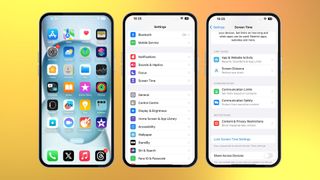
- Toggle Content and Privacy Restrictions
- Select Content Restrictions
- Tap Web Content
- Choose Limit Adult Websites
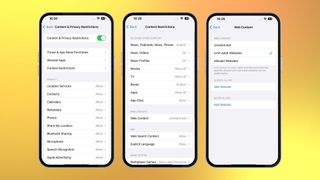
How to block specific websites in Safari for iPhone and iPad
If limiting adult content isn't enough, or you happen to notice a URL that has slipped through the cracks, you can always block any URL you want with restrictions. The steps are very similar:
- Toggle Content & Privacy Restrictions
- Tap Add a Website under NEVER ALLOW
- Type the URL of the website you wish to block in the Website field
- Select Back at the top left
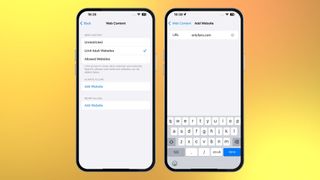
Repeat this process for each site you'd like to block. Keep in mind that if certain websites have mobile sites , you may need to block them separately. If you find a site that's still getting through after you attempt to block it, visit that site and look in the Address Bar of Safari to make sure you're blocking the correct URL. Copy it if you need to and paste it into the field.
How to block everything and whitelist only specific sites in Safari for iPhone and iPad
For very young children, or if you simply want to make sure nothing is accessible except what you specifically allow, you can disable everything and then only turn back on the sites you consider permissible, like Apple or Disney.
Master your iPhone in minutes
iMore offers spot-on advice and guidance from our team of experts, with decades of Apple device experience to lean on. Learn more with iMore!
- Choose Allowed Websites . This setting means only the websites you add are allowed to come through, and everything else is blocked
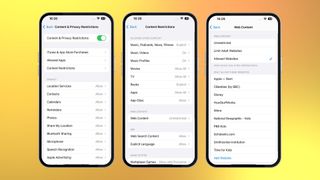
- Tap Add Website
- Add Title and URL for a custom website that you wish to add to your allow list
- Choose Back
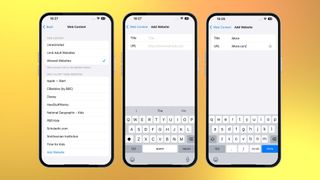
Keep unwanted content off your kids' devices
There you have three different ways to block websites on iPhone. Each one is progressively more comprehensive, and as such requires slightly more steps each time. As mentioned, we would generally recommend starting with the general "limit adult websites," before progressing to more specific URL blocking if you want stronger controls. The "allowed websites" setting we'd generally recommend the most for devices used by young children. Using these tools will take away any worries of your children using one of the best iPhones .

Stephen Warwick has written about Apple for five years at iMore and previously elsewhere. He covers all of iMore's latest breaking news regarding all of Apple's products and services, both hardware and software. Stephen has interviewed industry experts in a range of fields including finance, litigation, security, and more. He also specializes in curating and reviewing audio hardware and has experience beyond journalism in sound engineering, production, and design. Before becoming a writer Stephen studied Ancient History at University and also worked at Apple for more than two years. Stephen is also a host on the iMore show, a weekly podcast recorded live that discusses the latest in breaking Apple news, as well as featuring fun trivia about all things Apple. Follow him on Twitter @stephenwarwick9
- John-Anthony Disotto How To Editor
Apple issues fix for Palestinian flag controversy in iOS 17.5
iOS 17.5 and iPadOS 17.5 beta 2 drops to developers enrolled in program
M4 MacBook Pro: Everything you need to know
Most Popular
- 2 Apple accused of using blood minerals from a region 'devastated by grave violations of human rights' in its products
- 3 Did Apple just email you to say your trade-in is canceled? Don't panic, it's a glitch
- 4 On-device iOS 18 AI features tipped as Apple makes new open source LLM tools available online
- 5 This Australian iPhone can use the EU's third-party app stores and more, but it's a messy workaround you probably shouldn't try

How to Disable or Enable Content Blockers for a Website in Safari on Mac
Annoying ads and popups may easily clutter your Safari screen. Safari’s content blocking feature offers a smooth web browsing experience. This feature enables users to control their browsing experience by blocking certain types of content from loading when they visit websites. This content might include advertisements, tracking scripts, popups, and other elements that might slow down your browsing experience or compromise your privacy.
For example, some websites may have a lot of popup ads. These ads may take up much of the screen space, annoy people with poor graphics or auto-playing audio or video, or prevent them from seeing the site content, and slow down the website. These are the main reasons why Apple implemented native support for content blockers in its Safari browser.
Even though content blockers are very useful, you may experience problems using them on certain websites. You may not want to block popups on these websites, for example, Wi-Fi captive login popups, or password popups on banking websites. In this article, I will show you how to disable or enable content blockers for select websites.

Steps to disabling content blockers for individual sites in Safari on Mac
- Open the website for which you want to modify your content blocker settings. In this article, I will use macreports.com.
- Move your cursor over the URL field and then right-click (or Control-click) it and select Settings for [ domain.com ] .

- This will open a window, as you can see below. Then, uncheck the box for Enable content blockers .

The page will automatically be reloaded, and your changes will take effect. You can follow the same steps to re-enable the content blockers for the site again. Content blocking setting will only be changed for this specific site; content blocking will still work for other sites.
The steps above are the easiest way to do this. However, you can also do this by going to Safari > Settings > Websites > Content Blockers . This screen will enable you to change the content blocker setting on all open sites at once. Simply open the on/off drop-down menu next to an open website.

Related articles
- How to Disable ‘App’ Would Like to Paste from ‘App’ Popups on iPhone
- How to enable Cookies on iPhone
- Does your Mac Need Antivirus?
Dr. Serhat Kurt worked as a Senior Technology Director specializing in Apple solutions for small and medium-sized educational institutions. He holds a doctoral degree (or doctorate) from the University of Illinois at Urbana / Champaign and a master’s degree from Purdue University. He is a former faculty member. Here is his LinkedIn profile and Google Scholar profile . Email Serhat Kurt .
Similar Posts
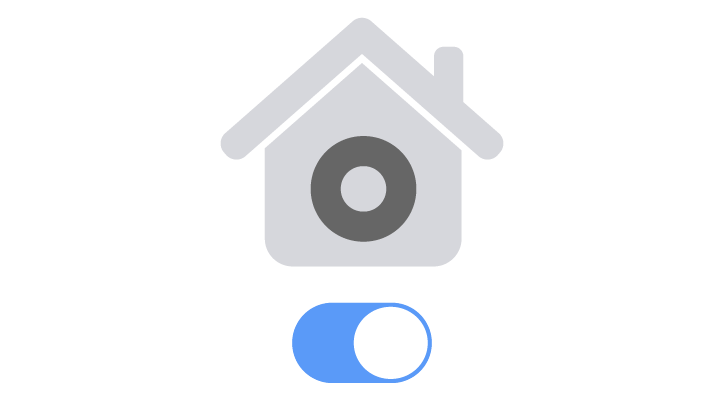
What is FileVault and How to Turn It On and Off
FileVault is a disk encryption feature to help protect the data stored on your startup disk. How this works is that your content is converted into code in real time that cannot be…
iPhone: How To Block “No Caller ID” Calls
Are you getting a lot of calls from unknown callers (e.g., spammers, telemarketers etc) with “No Caller ID”. You may want to block these calls because you cannot possible identify the number of a caller…
How to Send a Starbucks Gift Card by Text Message
You can send electronic Starbucks gift cards to other iOS or Android users via text messages. This article shows how you can do that in the Messages app. You can use this method…

How to Stop ‘New Photos Memory’ Notifications on iPhone, iPad, Apple Watch and Mac
You may like the Memories feature in Photos on your iPhone, iPad or Mac, but you may not want to be interrupted by a notification about it. Many apps try to notify you…
Mac Monterey Keeps Crashing, Fix
Several Mac users are experiencing occasional system crashes after updating to macOS Monterey. Some said that the Mac restarts randomly. Some have experienced crashes after waking their Mac from sleep rebooting to the…
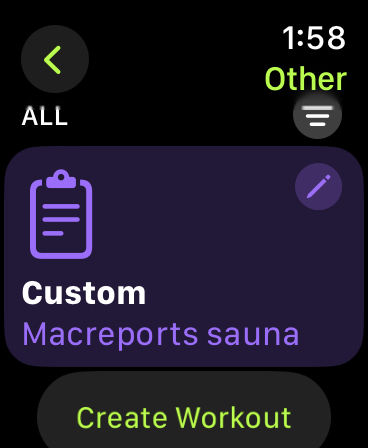
How to Add Sauna to Apple Watch Workouts
I go to the sauna often and wear my Apple Watch there (even though it is not recommended to have an Apple Watch in the sauna). Saunas produce extremely high temperatures and humidity…
Leave a Reply Cancel reply
Your email address will not be published. Required fields are marked *
Categories:
How to Permanently Block Websites on Safari on Mac
You can access just about any website on Safari, but there are times when you’d want to block some websites for one reason or another. Maybe you share your Mac with your family, or your kids use it for school and entertainment. Maybe you just prefer not to access certain websites. Whatever the reason, Mac allows you to block websites from launching on Safari.
There are several ways to block websites on Safari on your Mac, the obvious being third-party website blocker apps. But you can also block websites using Mac’s Screen Time feature, and in Safari through your router. Not sure how that works? We’ve got you covered. This article will show you all the ways to block websites on Safari on your Mac.
Before we start Browser extensions can be useful for blocking ads and overall convenience. However, having too many of them can slow down your Mac’s performance. Consider disabling some browser extensions on your Mac. Of course, you can do this manually, but if you want to save time, you can let MacKeeper do it for you in a whim. That’s just a fraction of what MacKeeper can do for your Mac. Check it out and see for yourself. Download MacKeeper now to keep your MacBook in optimal condition.
Let’s have a look at all the ways you can block websites on Safari on your Mac.
In this article you will find the following:
- How to block websites on Safari on Mac
You might already know how to block undesirable websites on Google Chrome , but did you know you can also do the same on Safari? You can block unwanted sites on Safari on your Mac in four ways.
How to block websites in Safari on a Mac using Screen Time
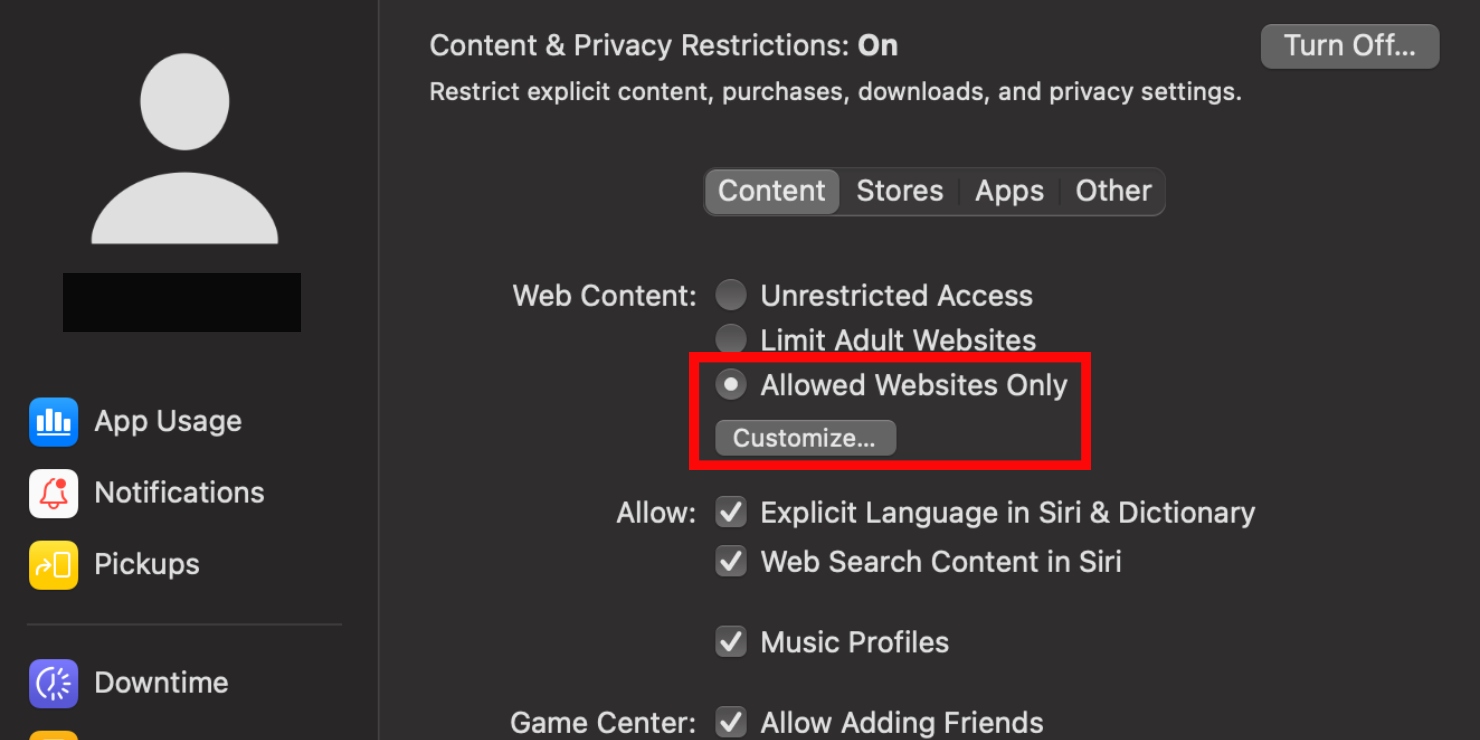
Apple’s Screen Time helps you manage and track usage on apps and websites on your Mac. In addition to scheduling downtime and setting limits, it allows you to block unwanted websites on your Mac.
The first way to do this is by choosing the websites you want to access on Safari:
- Open System Preferences on your Mac, then click on Screen Time
- Click on Content & Privacy on the left of the screen
- In the top-right corner, click Turn On Content & Privacy Restrictions
- Now click on Allowed Websites Only , followed by Customize … to choose a list of websites you want to access through Safari on your Mac. This will block any website not listed from opening. Your Mac will let you know each time it blocks those websites in the background
The second method is to block particular websites.
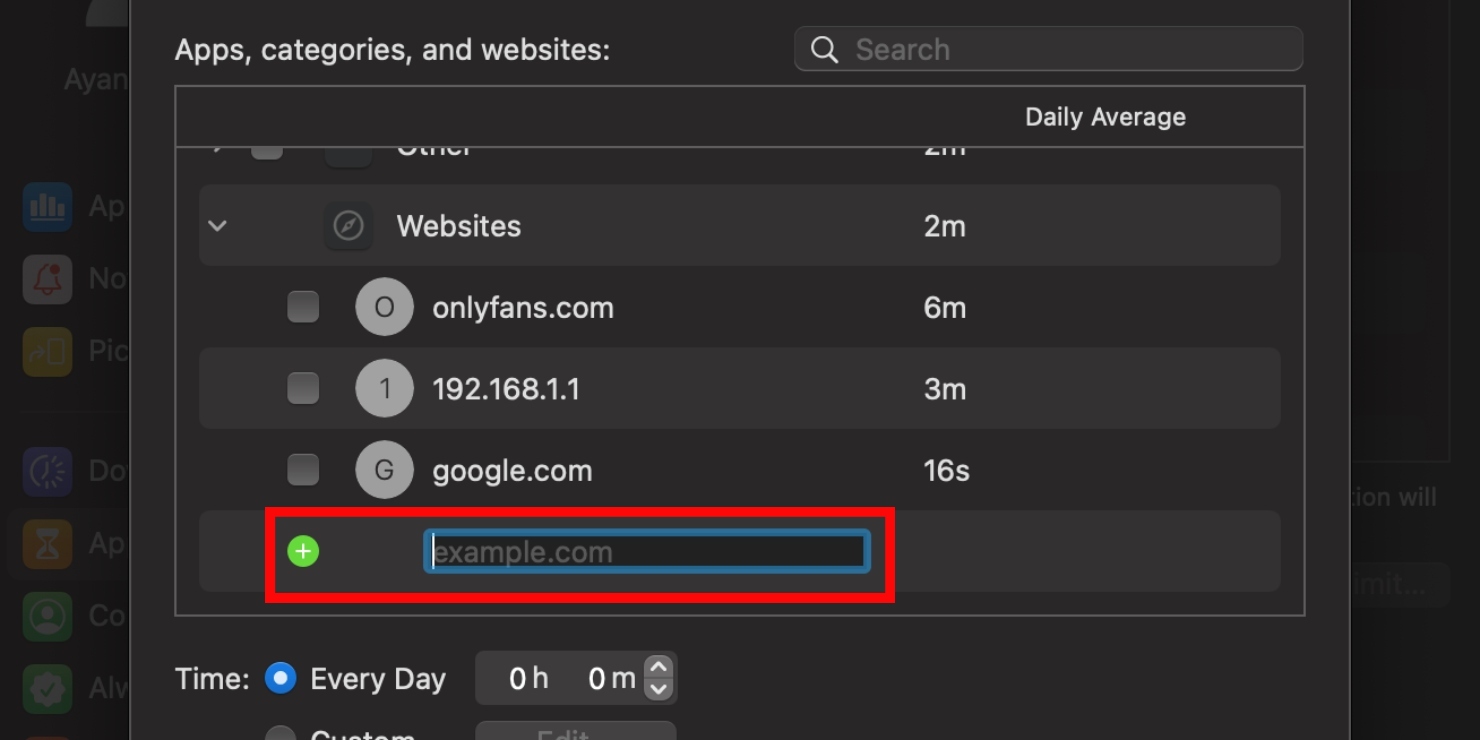
- Open System Preferences , then click on Screen Time
- Click on App Limits on the side bar on the left of the screen
- Click Turn On App Limits in the top-right corner
- Now click on the plus icon in the bottom-left corner of the App Limits box
- Scroll down to Websites and click on the arrow on the left to see a list of possible websites to block. You can also add more websites to the list by clicking on the green plus icon and paste or type the URL of the website in the text box . If you want to block that website completely, leave the Time field as is at 0h 0m. Alternatively, you can choose the amount of time you want to spend on the website each day using the arrows next to Every Day . You can also set a custom time by clicking on Custom , followed by Edit . Now choose your daily time limit by checking the boxes
That’s it, you will now only be able to browse the websites you prefer.
How to block websites in Safari on a Mac with Terminal
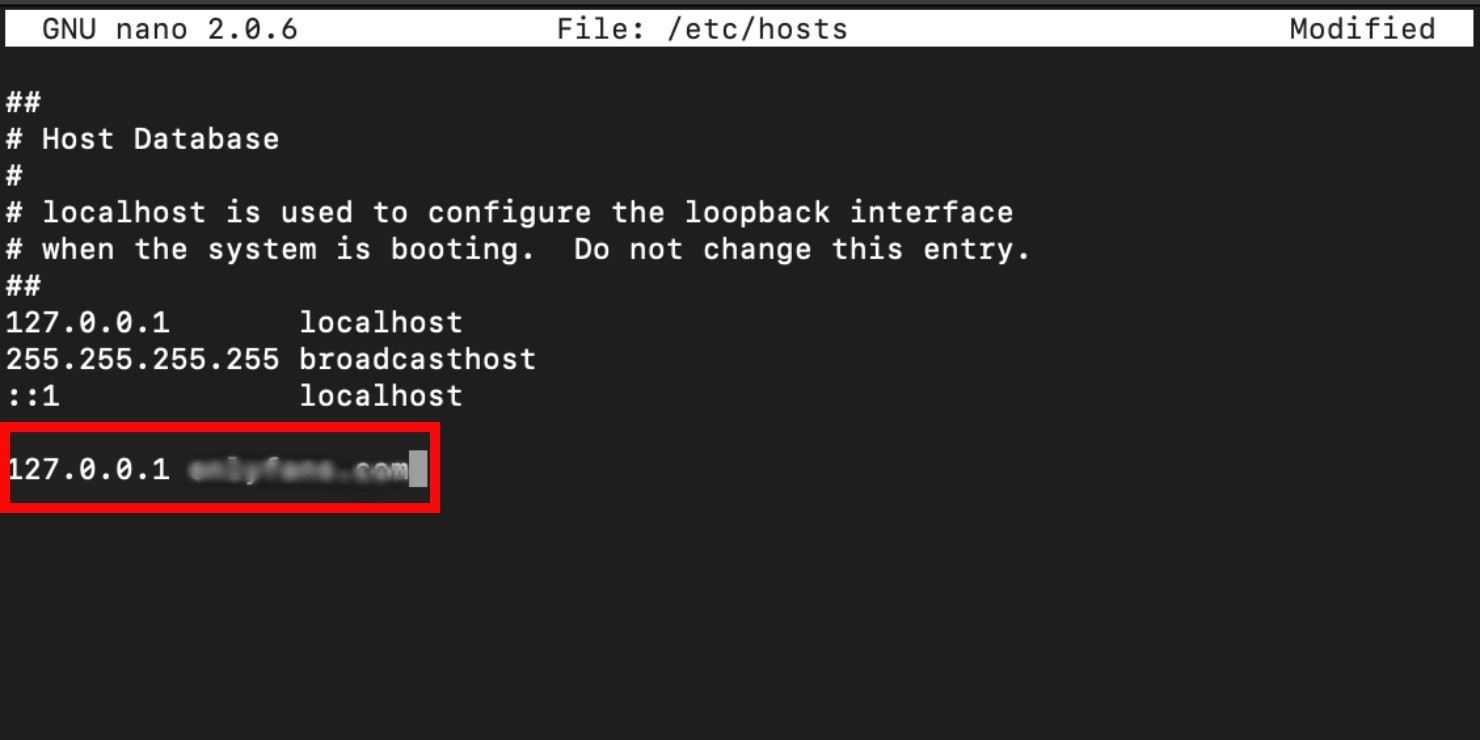
Terminal is Mac’s interface that allows you to block websites without parental controls. It works by blocking websites from opening on the local IP address. As this is a more technical method, only attempt it if you’re comfortable with using command-line prompts.
Launch Finder on your Mac:
- Click on Applicatons , then double-click on the Utilities folder
- Double-click on Terminal to launch it
- Start by backing up the host file. This is an important step, in case anything goes wrong. To back up the host file, type “sudo /bin/cp /etc/hosts /etc/hosts-original” on a new line and press the Return key
- Enter your Mac’s admin password when prompted, then press the Return key again.
- Type “sudo nano /etc/hosts”, followed by the Return key
- Using the down arrow key on your Mac, go to a new line and add the URL of the website you want to block, with the local IP address “127.0.0.1” before it, separated by a space. Be sure to add all the versions of the website on a new line, For example, “127.0.0.1 onlyfans.com” and “127.0.0.1 www.onlyfans.com”. Do this for every website you want to block
- When you’re done, press Control-O . Now press the Return key. Your blocked websites are now saved
- To exit Terminal, press Control-X
If you’re uncomfortable with using this method, there are more ways to block websites on Safari.
Related reading: How to use Terminal command line on your Mac
How to block websites in Safari on a Mac through router
Another way to block websites on your Mac is through your router’s settings:
1. Find your IP address on your router; it’s usually at the bottom. Alternatively, you can go to your Mac’s System Preferences > Network > Wi-Fi > Advanced… > TCP/IP . Your IP address will be shown next to Router
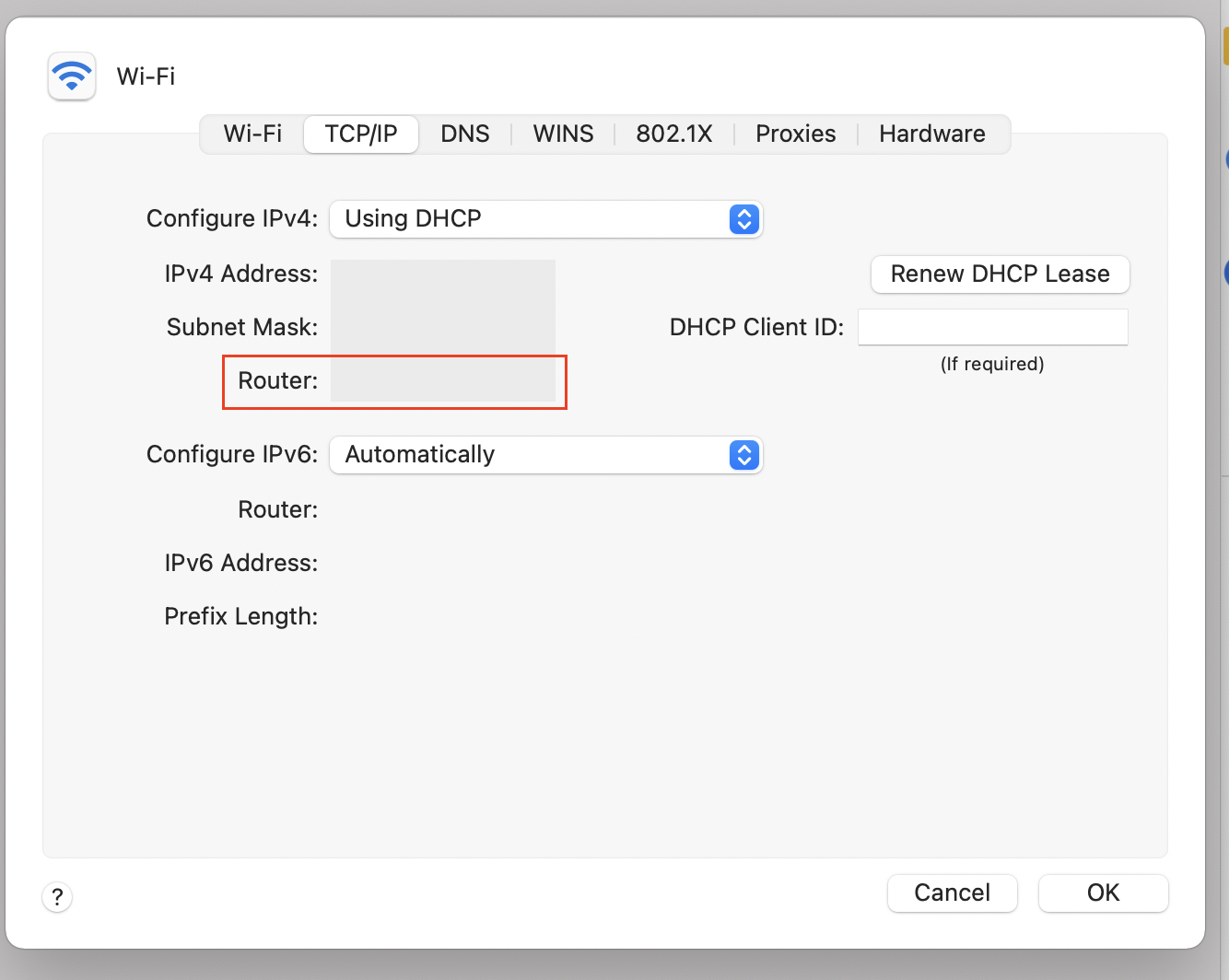
2. Type the address of the website you want to block in Safari
3. Now type your router’s admin name and password upon request
4. On the Settings page, find the options to block websites, and add each website you want to block
You’re all set. Just remember to do this again if you get a new router in the future.
How to block websites in Safari on a Mac using third-party website blocker apps
Up until now, we’ve showed you multiple ways to block websites on a device level. The final way to block websites on your Mac is with the help of third-party apps. Here are three apps we recommend:
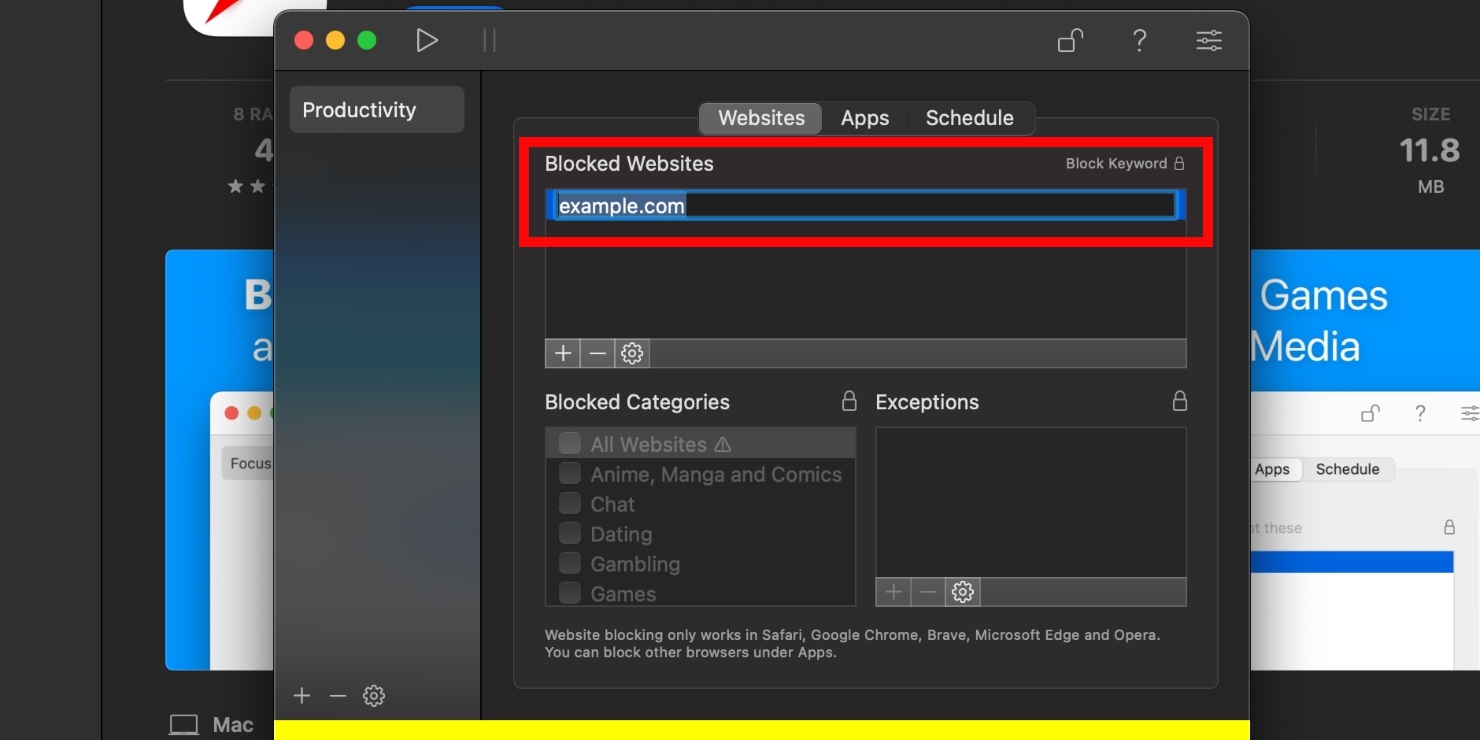
As the name suggests, 1Focus helps you stay focused on any work or task you’re busy with by eliminating distractions, like websites. This is one of the more popular focus apps. Blocking websites on 1Focus is easy.
1Focus allows you to block websites on the free version, but you can do more with in-app purchases. The free version lasts for 14 days, after which you’ll have to pay around $2/month or $10/year, unless you cancel your trial before the trial period is up.
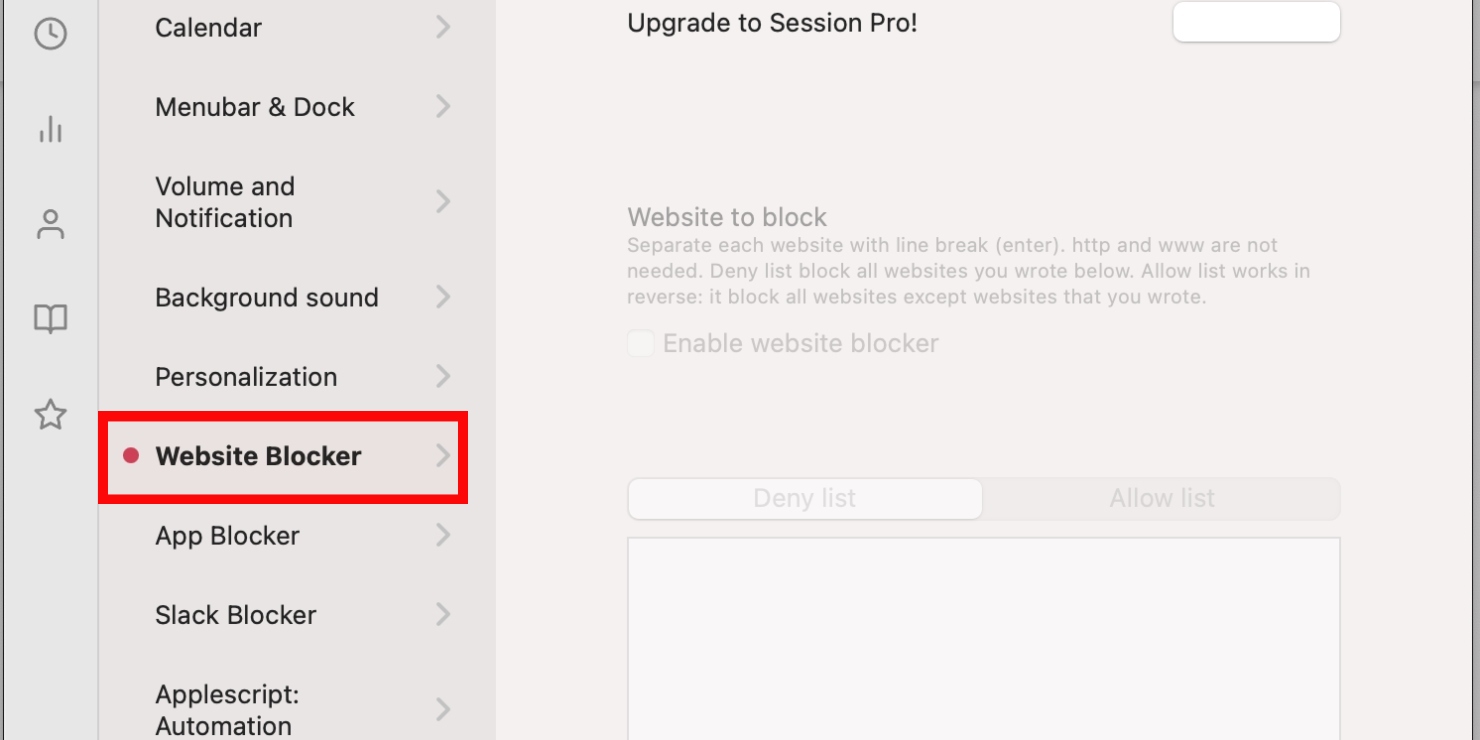
Session allows you to work in 25-minute sessions. What makes it unique is that it has a wellness element to it — the app prompts you to breathe before you start a new session and take a break when you’re done. You can block websites to limit distractions while you work or study. The app is free, but to use the Website Blocker feature, you’ll have to upgrade to the Pro version.
If you’re impressed with the free version of the app and are willing to upgrade, you’re looking at paying around $4/month.
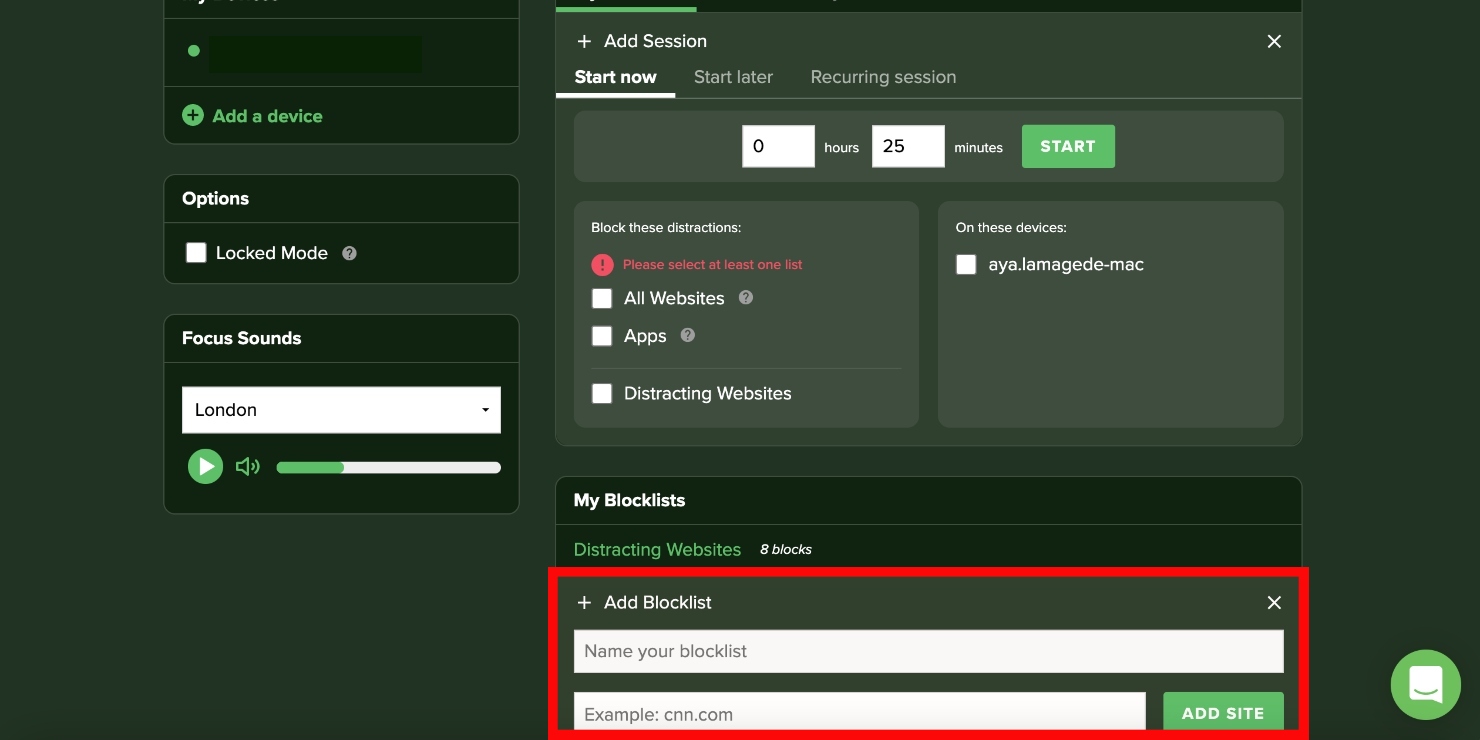
This focus app helps you limit distractions across all your devices simultaneously, unlike other website blockers which are device-specific. Like other apps, Freedom allows you to create a list of blocked websites. Checking the optional Locked Mode box locks in your sessions by not allowing you to edit your blocklists while you work.
Freedom offers you six free sessions. When you’ve used them up, you’ll have to pay $7/month to continue using the app.
- Block unwanted websites easily on your Mac
Mac offers multiple ways to block websites in Safari. Most of these are built-in solutions, but you can also block websites through apps found on the App Store and online. Choose the method that is most suitable to you from the options laid out in this article.
Read more:
- Why Is Safari Running Slow on Mac? 9 Ways to Fix
- How to Clear Cookies on Mac in Safari, Chrome & Firefox
- How to Delete History in Safari on a Mac in 4 Easy Steps
You’ll love exploring your Mac with us.
Oops, something went wrong.
Try again or reload a page.

- Delete unnecessary system files and caches
- Free up GBs of storage space
- Easily find and delete duplicate files
Remove unneeded Safari extensions with MacKeeper.

MacKeeper - your all-in-one solution for more space and maximum security.

We respect your privacy and use cookies for the best site experience.
Privacy Preferences Center
We use cookies along with other tools to give you the best possible experience while using the MacKeeper website. Cookies are small text files that help the website load faster. The cookies we use don’t contain any type of personal data meaning they never store information such as your location, email address, or IP address.
Help us improve how you interact with our website by accepting the use of cookies. You can change your privacy settings whenever you like.
Manage consent
All cookies
These cookies are strictly necessary for enabling basic website functionality (including page navigation, form submission, language detection, post commenting), downloading and purchasing software. The website might malfunction without these cookies.
Download MacKeeper when you're back at your Mac
Please enter your email so we can send you a download link
Check your email on your Mac
Install MacKeeper on your Mac computer to rediscover its true power.

Run Application

Click Continue

Click Install

Your macOS version is lower than OS 10.11. We’d like to offer you MacKeeper 4 to solve the cleaning, privacy, and security issues of your macOS.
How To Block Sites In Safari

- Software & Applications
- Browsers & Extensions
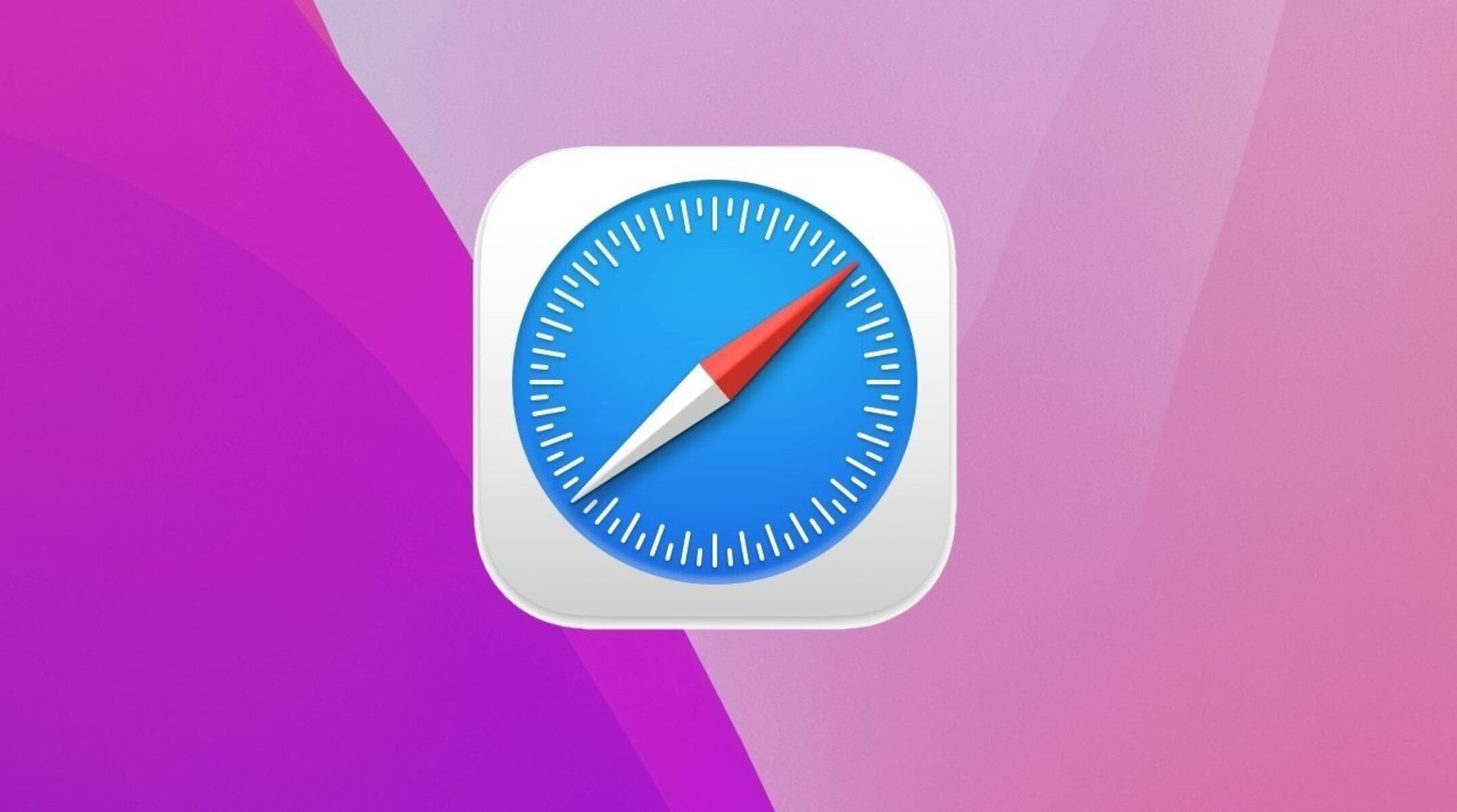
Introduction
Blocking specific websites in Safari can be a valuable tool for managing screen time, enhancing productivity, and ensuring a safer browsing experience. Whether you want to limit access to distracting sites, safeguard children from inappropriate content, or prevent certain websites from tracking your online activities, Safari offers several methods to achieve these goals. In this article, we will explore three effective ways to block sites in Safari, catering to different needs and preferences.
By implementing these methods, you can take control of your browsing environment and tailor it to align with your priorities. Whether you're a parent seeking to create a safer online space for your children, an individual striving to minimize distractions, or a user concerned about privacy and security, the ability to block specific websites in Safari empowers you to curate a browsing experience that reflects your values and objectives.
Now, let's delve into the step-by-step instructions for each method, enabling you to make informed decisions about which approach best suits your needs. Whether you opt for utilizing Screen Time, leveraging Parental Controls, or employing a Content Blocker Extension, you'll gain valuable insights into how to effectively block sites in Safari, ultimately enhancing your browsing experience.
Method 1: Using Screen Time
Utilizing Screen Time to block specific websites in Safari provides a seamless and integrated approach for managing online activities. This method is particularly beneficial for individuals seeking to exercise self-discipline, parents aiming to regulate their children's browsing habits, or anyone looking to establish a healthier balance between screen time and other activities.
Step 1: Accessing Screen Time Settings
To initiate the process, navigate to the "Settings" app on your iOS device and tap on "Screen Time." Within the Screen Time settings, select "Content & Privacy Restrictions" to proceed to the next step.
Step 2: Enabling Content & Privacy Restrictions
Upon entering the Content & Privacy Restrictions section, tap on "Content Restrictions" and then select "Web Content." Here, you can choose to "Limit Adult Websites" or "Allowed Websites Only." Opting for the latter enables you to specify which websites are accessible, effectively blocking all other sites.
Step 3: Adding Websites to the Allowed List
To add specific websites to the allowed list, tap on "Add Website" under the "Never Allow" section. Enter the URL of the website you wish to block and repeat this process for any additional sites you want to restrict access to.
Step 4: Verifying the Restrictions
After adding the desired websites to the restricted list, exit the settings and open Safari to ensure that the specified sites are now inaccessible. By leveraging Screen Time's capabilities, you can effectively enforce these restrictions and promote a more focused and controlled browsing experience.
By following these straightforward steps, you can harness the power of Screen Time to block specific websites in Safari, aligning your digital habits with your personal or parental preferences. This method empowers users to proactively manage their online environment, fostering a healthier relationship with technology and promoting a more intentional and mindful approach to browsing.
Method 2: Using Parental Controls
Utilizing parental controls in Safari offers a robust solution for managing and regulating the online activities of children and young users. This method empowers parents and guardians to create a safe and secure browsing environment, ensuring that children are shielded from potentially harmful or inappropriate content while navigating the digital landscape.
Step 1: Accessing Parental Controls
Step 2: enabling parental controls.
Under the Content & Privacy Restrictions section, tap on "Content Restrictions" and then select "Web Content." Here, you can choose to "Limit Adult Websites" or "Allowed Websites Only." Opting for the latter enables you to specify which websites are accessible, effectively blocking all other sites.
After adding the desired websites to the restricted list, exit the settings and open Safari to ensure that the specified sites are now inaccessible. By leveraging parental controls, you can effectively enforce these restrictions and promote a safer and more controlled browsing experience for children.
By following these straightforward steps, parents and guardians can leverage parental controls to block specific websites in Safari, providing a secure online environment for children and young users. This method empowers adults to proactively manage and monitor their children's digital interactions, fostering a safer and more nurturing online experience.
Method 3: Using a Content Blocker Extension
Harnessing a content blocker extension in Safari presents a versatile and customizable approach to blocking specific websites and enhancing the overall browsing experience. Content blocker extensions empower users to exert fine-grained control over the content they encounter online, ranging from ad-blocking to restricting access to particular websites. By integrating these extensions into Safari, individuals can tailor their browsing environment to align with their preferences, whether it involves minimizing distractions, bolstering privacy, or fortifying security measures.
Step 1: Identifying a Suitable Content Blocker Extension
The initial step in utilizing a content blocker extension involves identifying a suitable extension that aligns with your specific needs and browsing objectives. Safari offers a diverse array of content blocker extensions, each designed to address distinct aspects of online content regulation. Whether you prioritize ad-blocking, site-specific restrictions, or comprehensive content filtering, conducting thorough research to pinpoint an extension that resonates with your requirements is crucial.
Step 2: Installing and Configuring the Content Blocker Extension
Once you have selected a content blocker extension that aligns with your preferences, proceed to install it via the App Store or Safari Extensions Gallery. After installation, navigate to Safari's preferences and access the "Extensions" tab to configure the newly installed content blocker. Here, you can customize the extension's settings, including specifying the websites you intend to block or tailoring the extension's filtering parameters to suit your browsing habits.
Step 3: Implementing Website Restrictions
With the content blocker extension configured to your specifications, you can proceed to implement website restrictions by adding the URLs of the sites you wish to block. By inputting the relevant website addresses into the extension's settings, you can effectively prevent access to these sites when browsing with Safari. This granular control over website access empowers users to curate a personalized browsing experience that reflects their values and priorities.
Step 4: Verifying the Extension's Effectiveness
After configuring the content blocker extension and implementing website restrictions, it is essential to verify its effectiveness by navigating to the specified websites using Safari. By confirming that the designated sites are inaccessible, users can ensure that the content blocker extension is functioning as intended, thereby fortifying their browsing environment in alignment with their preferences.
By following these steps, users can leverage a content blocker extension to block specific websites in Safari, customizing their browsing experience to align with their individual preferences and priorities. This method empowers users to exercise precise control over their online interactions, fostering a tailored and refined browsing environment that reflects their values and objectives.
In conclusion, the ability to block specific websites in Safari empowers users to curate a browsing experience that aligns with their values, priorities, and objectives. Whether it involves fostering a safer online environment for children, minimizing distractions to enhance productivity, or fortifying privacy and security measures, Safari offers versatile methods to achieve these goals.
By leveraging Screen Time, individuals can seamlessly manage their online activities, promoting a more focused and controlled browsing experience. This method is particularly beneficial for parents seeking to regulate their children's digital habits and for individuals striving to establish a healthier balance between screen time and other activities.
Furthermore, utilizing parental controls in Safari provides a robust solution for creating a safe and secure browsing environment, ensuring that children are shielded from potentially harmful or inappropriate content. This approach empowers parents and guardians to proactively manage and monitor their children's digital interactions, fostering a safer and more nurturing online experience.
Additionally, harnessing a content blocker extension in Safari offers a versatile and customizable approach to blocking specific websites and enhancing the overall browsing experience. By integrating these extensions into Safari, individuals can tailor their browsing environment to align with their preferences, whether it involves minimizing distractions, bolstering privacy, or fortifying security measures.
In essence, the methods outlined in this article cater to a diverse range of needs and preferences, enabling users to exercise precise control over their online interactions. By following the step-by-step instructions for each method, individuals can effectively block specific websites in Safari, ultimately fostering a tailored and refined browsing environment that reflects their values and objectives.
Ultimately, the ability to block specific websites in Safari empowers users to take control of their digital habits, promoting a more intentional and mindful approach to browsing. Whether it's for personal use or to create a safer online space for children, the methods presented in this article equip users with the knowledge and tools to curate a browsing experience that resonates with their individual needs and aspirations.
Leave a Reply Cancel reply
Your email address will not be published. Required fields are marked *
Save my name, email, and website in this browser for the next time I comment.
- Crowdfunding
- Cryptocurrency
- Digital Banking
- Digital Payments
- Investments
- Console Gaming
- Mobile Gaming
- VR/AR Gaming
- Gadget Usage
- Gaming Tips
- Online Safety
- Software Tutorials
- Tech Setup & Troubleshooting
- Buyer’s Guides
- Comparative Analysis
- Gadget Reviews
- Service Reviews
- Software Reviews
- Mobile Devices
- PCs & Laptops
- Smart Home Gadgets
- Content Creation Tools
- Digital Photography
- Video & Music Streaming
- Online Security
- Online Services
- Web Hosting
- WiFi & Ethernet
- Browsers & Extensions
- Communication Platforms
- Operating Systems
- Productivity Tools
- AI & Machine Learning
- Cybersecurity
- Emerging Tech
- IoT & Smart Devices
- Virtual & Augmented Reality
- Latest News
- AI Developments
- Fintech Updates
- Gaming News
- New Product Launches
- Fintechs and Traditional Banks Navigating the Future of Financial Services
- AI Writing How Its Changing the Way We Create Content
Related Post
How to find the best midjourney alternative in 2024: a guide to ai anime generators, unleashing young geniuses: how lingokids makes learning a blast, 10 best ai math solvers for instant homework solutions, 10 best ai homework helper tools to get instant homework help, 10 best ai humanizers to humanize ai text with ease, sla network: benefits, advantages, satisfaction of both parties to the contract, related posts.
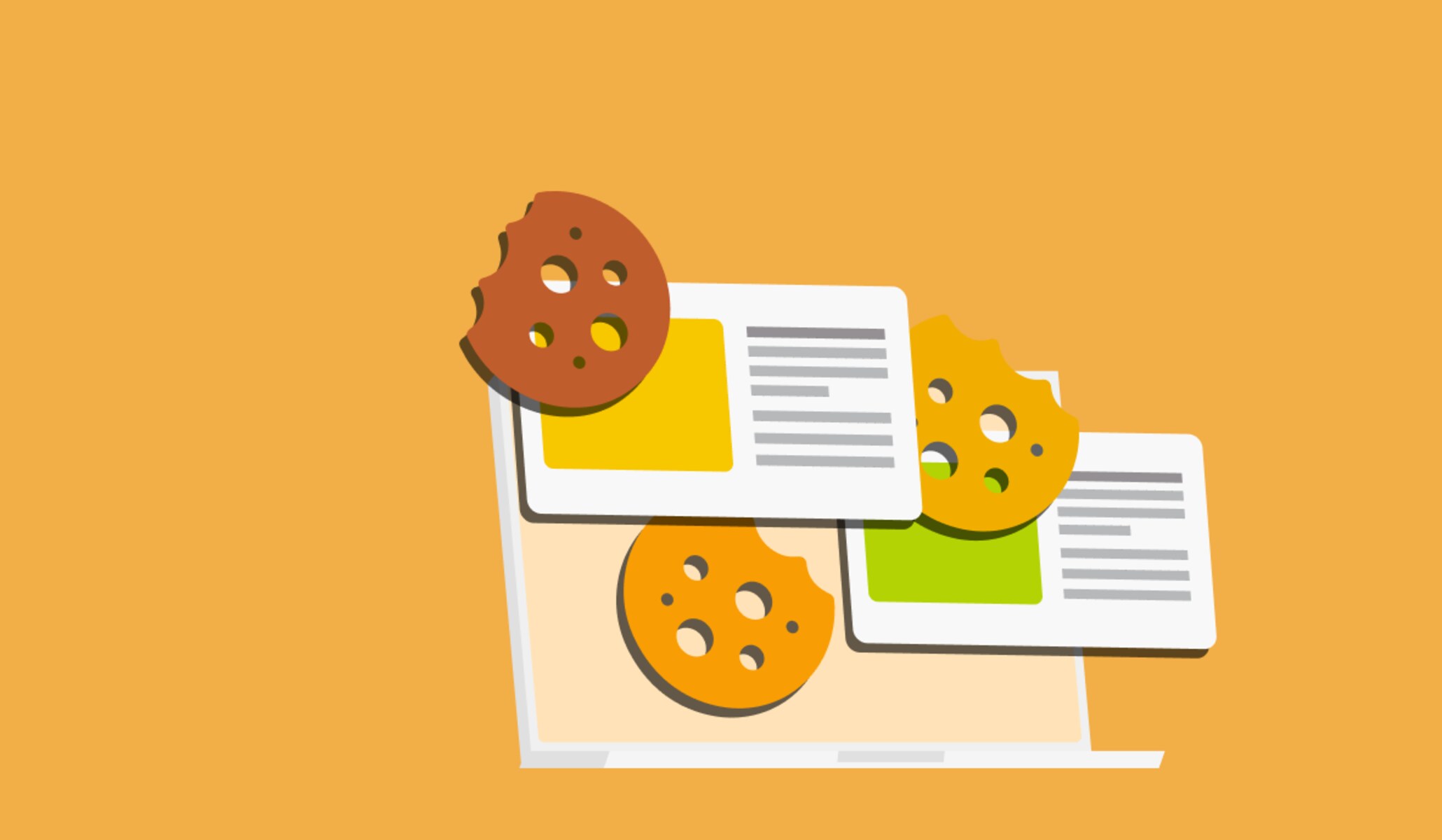
How Do I Allow 3Rd Party Cookies On Safari
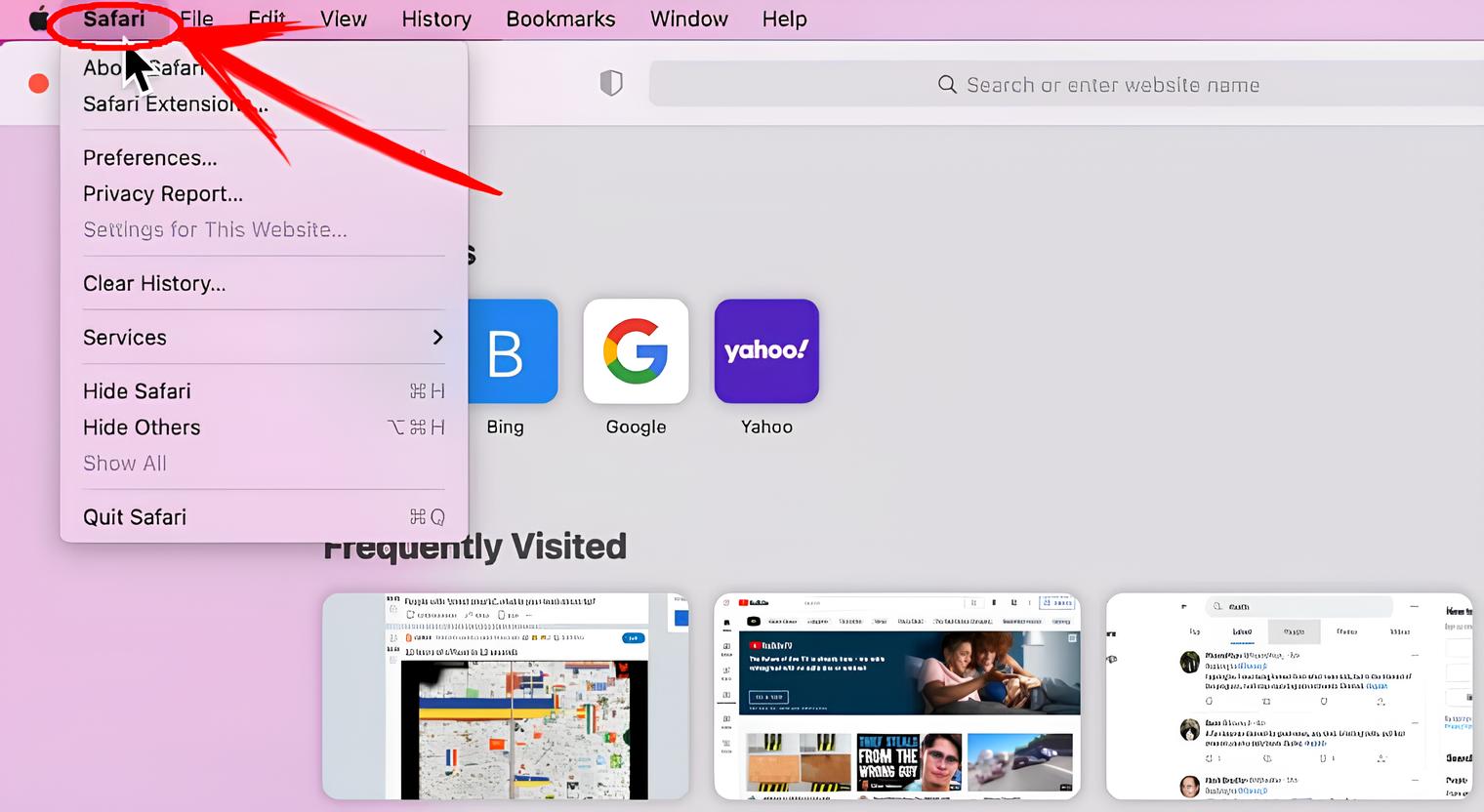
How To Enable Third-Party Cookies On Safari
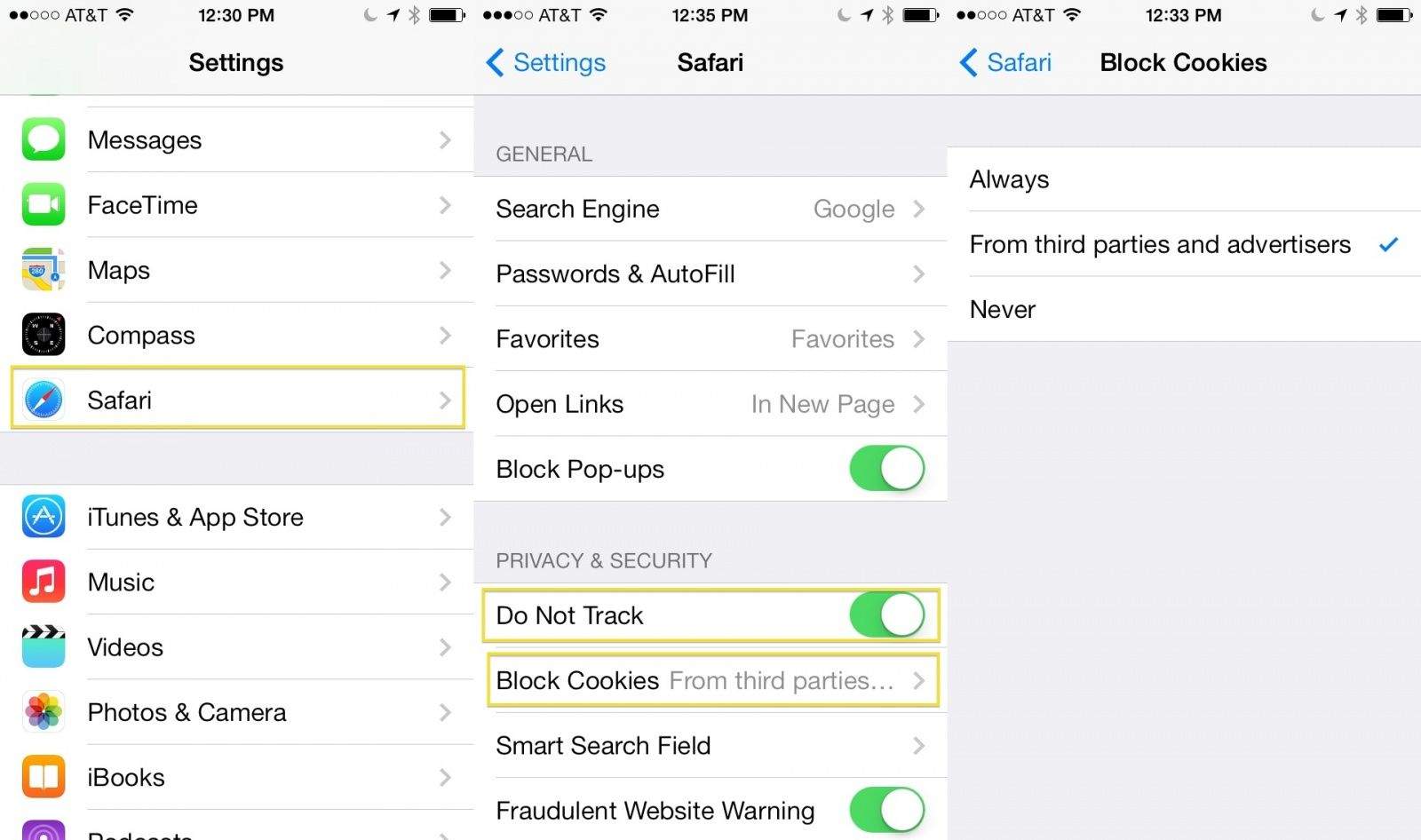
How To Block Cookies In Safari
What Is Cross-Site Tracking In Safari
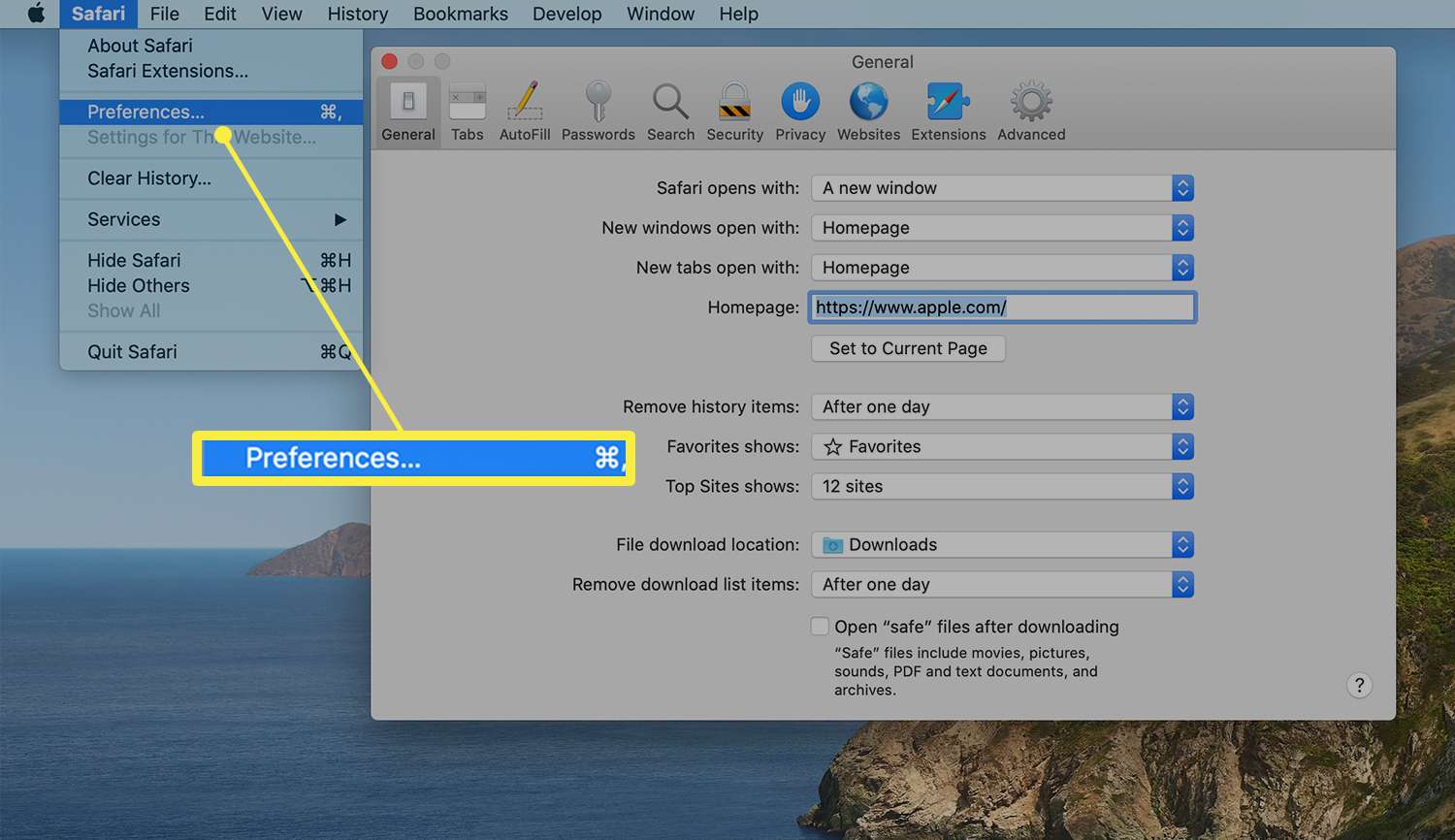
How To Turn Off Cookies In Safari
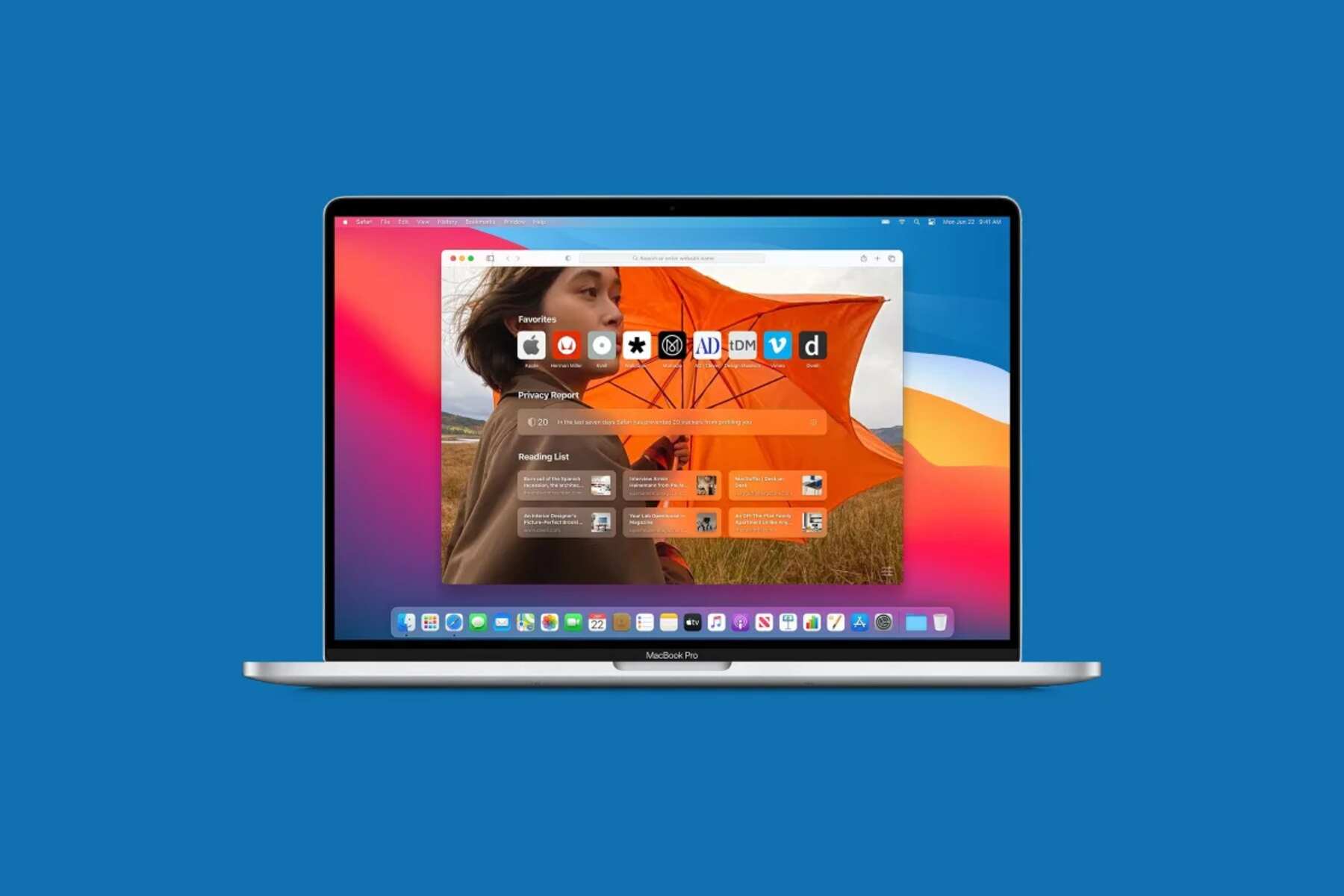
What Is Safari Privacy Report
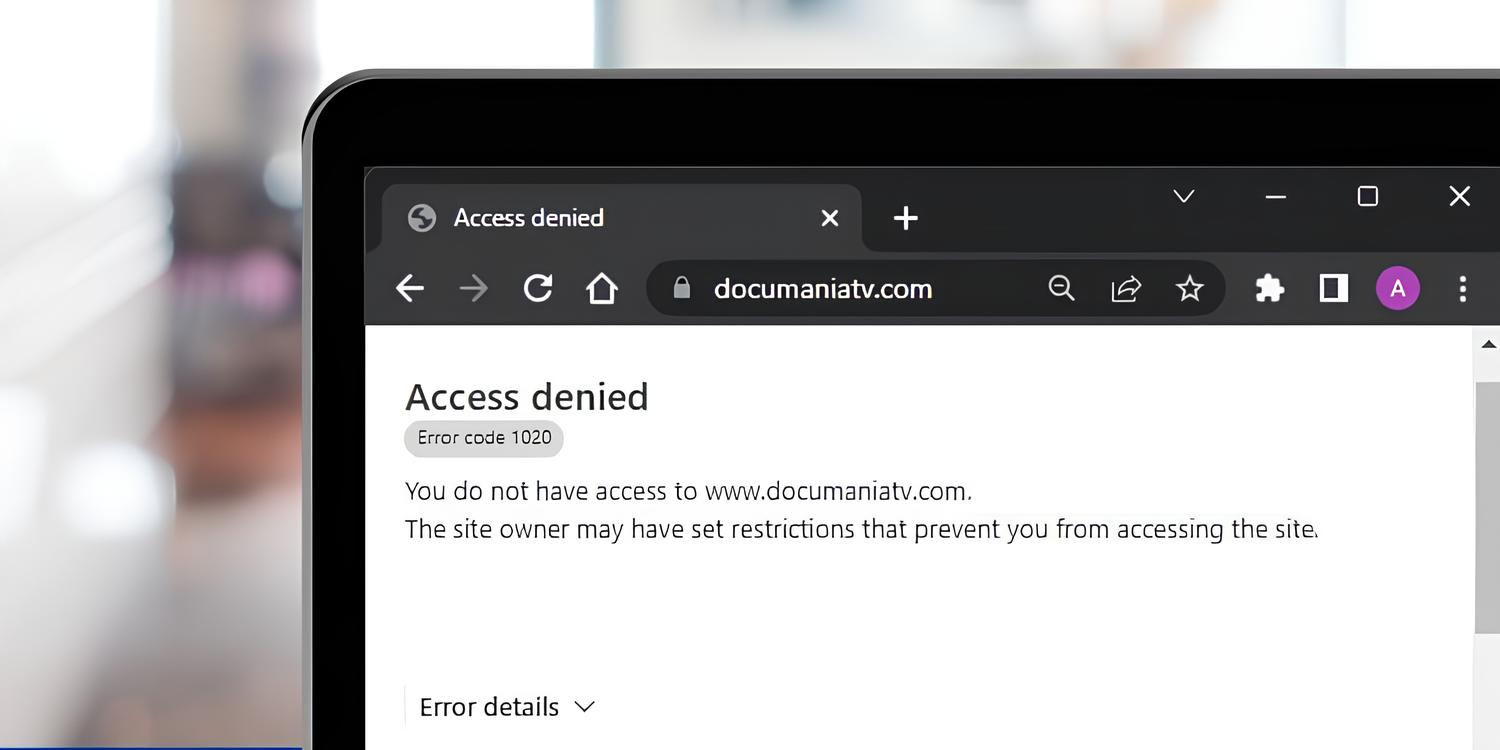
Why Do I Get Access Denied On Safari
How To Allow Cross-Site Tracking In Safari On Mac
Recent stories.

Fintechs and Traditional Banks: Navigating the Future of Financial Services

AI Writing: How It’s Changing the Way We Create Content

How to Know When it’s the Right Time to Buy Bitcoin

How to Sell Counter-Strike 2 Skins Instantly? A Comprehensive Guide

10 Proven Ways For Online Gamers To Avoid Cyber Attacks And Scams

- Privacy Overview
- Strictly Necessary Cookies
This website uses cookies so that we can provide you with the best user experience possible. Cookie information is stored in your browser and performs functions such as recognising you when you return to our website and helping our team to understand which sections of the website you find most interesting and useful.
Strictly Necessary Cookie should be enabled at all times so that we can save your preferences for cookie settings.
If you disable this cookie, we will not be able to save your preferences. This means that every time you visit this website you will need to enable or disable cookies again.
How to Block Websites in Safari Web Browser
Here's how you can block websites in the Safari web browser!
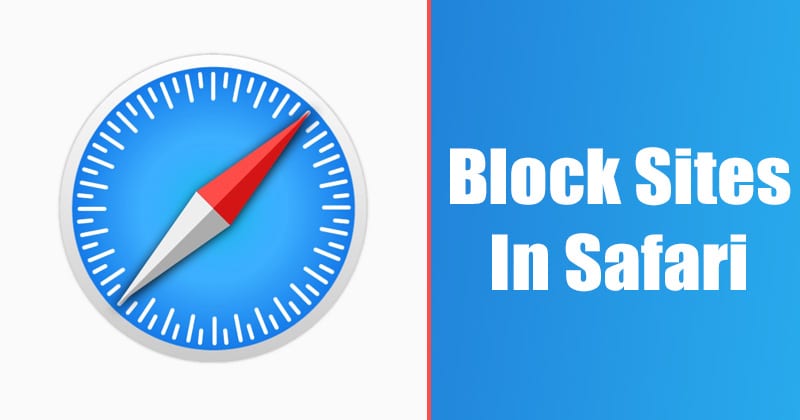
If you are a huge fan of Apple devices, you might be well aware of the Safari web browser. Safari is a graphical web browser developed by Apple, and it comes built-in with iOS and macOS devices. Although Apple’s Safari is far from perfect, it’s still considered one of the leading web browsers.
Unlike Chromium-based web browsers like Google Chrome, Microsoft Edge, etc., Safari consumes less RAM and power resources. Safari web browser does bring some robust customization options and powerful privacy protection. One of the Safari web browser’s best privacy features is the ability to block sites.
Look, there could be multiple reasons why you want to block a specific site, maybe you don’t want other members of your family to access those sites, or you want to block a particular website that kills your most precious time. So, whatever might be the reason, you can permanently block websites in the Safari browser on your Mac and iPhone.
Also Read: How to Download & Install Safari Browser on Windows 10
Steps to Block Websites in Safari Web Browser
In this article, we will share a detailed guide on how to block websites in the Safari web browser for macOS and iOS. So, let’s check out.
Block websites in Safari on Mac
Well, to block websites in the Safari browser on Mac, we need to use the Parental Control feature. The Parental Control feature is present in the System preferences panel on your MAC. So, here’s how to use it to block sites in Safari.
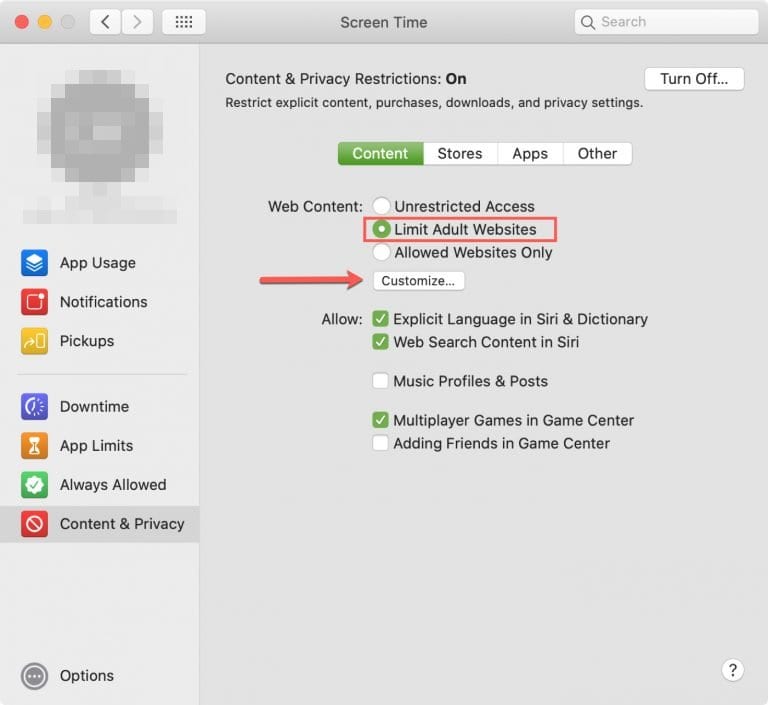
- First of all, click on the Apple logo and then click on the ‘System Preferences. ‘
- On the System Preferences page, click on the option Screen Time .
- Next window, click on the ‘Content & Privacy’ option. If the Content & Privacy restrictions is disabled, click on it to turn it on .
- On the next page, click on the ‘Limit Adult website. ‘ This will automatically block the adult websites.
- If you want to block a specific website manually, click on the ‘Customize’ button, and under the restricted section, click on the (+) icon.
- Now type in the URL of the website that you want to block. Next, click on the ‘Ok’ button.
That’s it! You are done. This is how you can block specific websites in Safari on MAC.
Block websites in Safari on iPhone
The process to block websites in Safari on iPhone is the same. However, the settings might vary a little bit. So, follow some of the simple steps given below to block websites in Safari on iPhone.
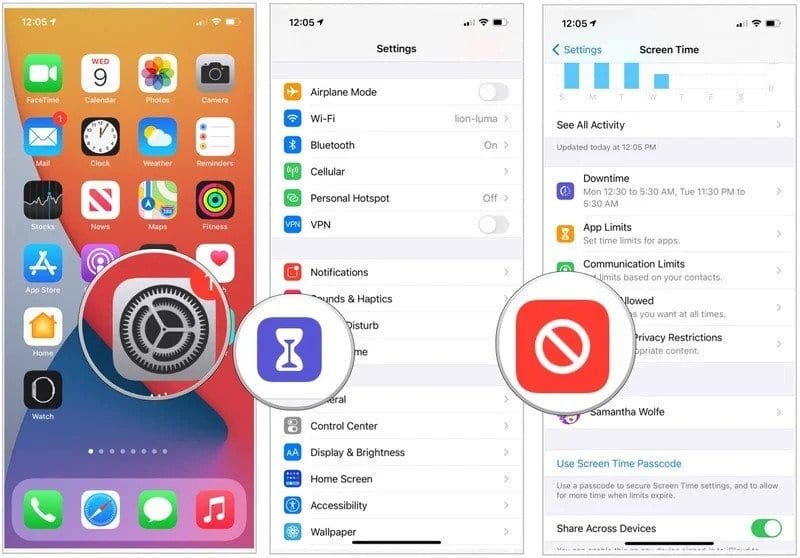
- First of all, tap on the ‘Settings’ app on your iPhone.
- On the Settings page, tap on the ‘Screen Time’ option.
- Next, tap on the ‘Content & Privacy Restrictions’ option.
- On the next page, use the toggle button to enable the ‘ Content & Privacy Restrictions’ on your iPhone.
- Next, browse to the Content Restrictions > Web Content > Limit Adult websites .
- If you want to block any particular website, then select ‘Allowed Websites Only’ on the previous step.
- Under the Never allow section, tap on the ‘Add website’ and add the website URL.
That’s it! You are done. This is how you can block specific websites in the Safari browser on iOS.
This article is all about blocking websites in the Safari browser on MAC and iOS. I hope this article helped you! Please share it with your friends also. If you have any doubts about this, let us know in the comment box below.
RECOMMENDED ARTICLES RELATED ARTICLES
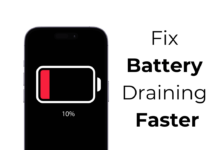
How to Fix Battery Draining Faster after iOS 17.4.1 Update
How To Turn Your Android Phone into an Ultimate Fitness Tracker
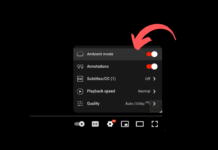
How to Enable Ambient Mode on YouTube (Desktop & Mobile)
Leave a reply cancel reply.
Save my name, email, and website in this browser for the next time I comment.
15 Amazing Apps To Enhance Music Experience on Android
Apple confirms swiping apps don’t save battery life on iphone, 10 best movie apps for android to watch movies online.
- Privacy Policy
Looks like no one’s replied in a while. To start the conversation again, simply ask a new question.
Why is Safari blocking a website I use all the time?
For some reason Safari decided to block access to the Wacom site. I'm getting the 403 Forbidden error.
I have an iMac (Retina 5K, 27-inch, 2017), Big Sur 11.6.8.
Posted on Sep 21, 2022 3:44 PM
Posted on Sep 21, 2022 6:05 PM
Try clearing Safari's saved website data and / or history.
Clear your browsing history in Safari on Mac - Apple Support
Manage cookies and website data in Safari on Mac - Apple Support
If Safari on Mac doesn't open a webpage or isn't working as expected - Apple Support
Similar questions
- 403 error codes in Safari but not on Chrome Hi. I have a fresh install of Wordpress running on a new MBP 10.15.2 When I try and preview a slider I am creating with Safari 13.0.4 I am getting 403 error messages: Failing to load resource - server responded with a status of 403 Forbidden. If I preview the slider in Chrome, it works perfectly. Can anyone tell me what the issue is likely to be and how to fix it. Thanks Alex 1633 2
- 403 Forbidden message I keep getting the 403 Forbidden message on my Mac when I try to access a site I have used many times before without any problem. It is a legitimate and completely safe site from a National Organisation, but I now cannot access it because of the repeated message. The same message comes up when I try on all my other devices too. Phone, Tablet etc. Can anyone help please? 523 1
- I can't search using Google as I get a 403 forbidden error on my Macbook Pro but I can search with Google when I use my Chromebook. How do I fix this? I can't search using Google as I get a 403 forbidden error on my Macbook Pro but I can search with Google when I use my Chromebook. How do I fix this? 240 1
Loading page content
Page content loaded
Sep 21, 2022 6:05 PM in response to seven orbs
- Skip to primary navigation
- Skip to main content
- Skip to footer
Tech Spirited
How to Block Websites on Safari
Blocking websites on any web browser helps in preventing your kids or employees from visiting websites you don't want them to access. In this article, you will find a fully-explained procedure to block websites on Apple's Safari web browser.
Like it? Share it!

Blocking websites on any web browser helps in preventing your kids or employees from visiting websites you don’t want them to access. In this article, you will find a fully-explained procedure to block websites on Apple’s Safari web browser.
Safari is the default browser for Mac OS X, as well as iOS. Since its release in 2003, this browser has become the fourth most widely used web browser. The Internet is a wide domain with many websites. If you own a home PC, you want to make sure your kids do not land up on sites, that you do not want them to see. Maybe you do not want your employees to waste precious productive hours in surfing social networking sites. The best way to restrict Internet access is by blocking them using the browser itself. Let’s see how you can do this using Safari.
Blocking Websites on Safari Using Parental Controls Safari offers built-in parental controls that makes it very easy to block websites. Let’s look at instructions for blocking websites on Safari.
- Open the Application folder on the OS X and go to ‘System Utility’.
- Once you open it, click on the ‘Accounts’ icon present in the System row.
- You will find a button called the ‘lock’ icon at the bottom of the Accounts window. You will need to add a new Account to the system by entering your admin password.
- To add a new account, just click on the ‘+’ sign that you will find in the lower left side of the screen.
- You will see a new window pop up, asking you to enter a name, short name, password, and password hint. Make sure the box saying ‘all admin’ is not checked. If it is, only this particular user will be able to add and delete accounts.
- Now, click on ‘create account’ and then when prompted, click on ‘Turn Off Automatic Login’.
- After you do so, click on the name of the new user. Then, click on ‘Parent Controls’ present on the top of the screen.
- When you do so, you will find a new window and click on the box next to ‘Safari’. Click the ‘Configure’ button present on the right. You will be asked to log in as the new user. When this is done, Safari will help you to configure the sites that the user can access.
- Now, ‘Log Out’ from the Apple menu and log in again as the new user.
- You will have to launch Safari and go to ‘Preferences’ → ‘Security’ from the menu.
- Uncheck the box that says ‘Enable Parental Controls’. You will have to enter the admin password and close the box.
- You should now add all the bookmarks of the sites that are allowed and remove all other bookmarks.
- Go back to ‘Preferences’ → ‘Security’ from the Safari menu and choose the check box that says ‘Enable Parental Controls’. Enter the admin password and lock the changes.
Another Blocking Technique There is another method that will help you block websites from the PC itself. Whether you are a Windows or Mac user, you must follow the same instructions. Windows users need to go to, or copy paste the following path in the Start Search menu:
C:\WINDOWS\system32\drivers\etc\
Mac users, on the other hand, need to go to the Menu Bar → Utilities → Terminal and type the following words:
sudo pico /etc/hosts
When you type in the paths in either Windows or Mac, you will be guided to the host file. Open the host file using Notepad. You will find the following file open:
Now, below the 127.0.0.1 local host , type in 127.0.0.1 facebook.com or 127.0.0.1 myspace.com or 127.0.0.1 twitter.com . Keep adding the websites you wish to block, one beneath the other. If you wish to block specific parts of the website then, you need to type the following. For example:
127.0.0.1 search.myspace.com 127.0.0.1 profile.myspace.com
Make sure you test each of the sites on Safari, after blocking them. Save the file and these particular websites will be blocked. If you wish to unblock these sites, simply delete them from the host file.
Get Updates Right to Your Inbox
Privacy overview.
- Home New Posts Forum List Trending New Threads New Media Spy
- WikiPost Latest summaries Watched WikiPosts
- Support FAQ and Rules Contact Us
Safari extension: Custom URL Blocklist?
- Thread starter mattspace
- Start date Yesterday at 12:02 AM
- Sort by reaction score
macrumors 68040
- Yesterday at 12:02 AM
- Single purchase, not interested in subscription products.
- Doesn't need pre-configured blocklists - I already have an ad-blocker (which doesn't do this already).
- From a developer that doesn't use tracking, metrics or anything else.
macrumors Haswell
- Yesterday at 5:41 AM
Sounds like you want to use a firewall app like Little Snitch
- Yesterday at 6:02 AM
maflynn said: Sounds like you want to use a firewall app like Little Snitch Click to expand...
macrumors 603
- Yesterday at 8:33 AM
Parental Control Web Content Filter Payload: restrictWeb & filterBlacklist https://developer.apple.com/documentation/devicemanagement/parentalcontrolscontentfilter iMazing Profile Editor https://apps.apple.com/app/id1487860882
macrumors 68020
- Yesterday at 3:38 PM
mattspace said: I already have an ad-blocker (which doesn't do this already) Click to expand...
- Yesterday at 9:40 PM
gilby101 said: Don't all adblockers allow custom lists? Maybe time for you to change to change. I use Adguard, but your choice is wide. Click to expand...
Your Guide to Private Browsing in Safari
Private browsing is often misunderstood, but it can be a helpful feature if you know what’s what.
Quick Links
What private browsing does in safari, how to use safari private browsing on iphone and ipad, how to use safari private browsing on a mac, how to disable safari private browsing on iphone and ipad, how to disable safari private browsing on a mac, key takeaways.
- Private Browsing in Safari hides browsing history, autofill details, downloads, and locks tabs after inactivity.
- Safari on Mac groups private and non-private tabs, while on iPhone it shows all tabs regardless of mode.
- To use Private Browsing in Safari, identify it by a dark address bar, "Private" indicator, or "Private" next to the site URL.
Most browsers offer a private browsing mode that aims to keep the websites you view off the record. But what exactly does it do in Safari and how do you get the best out of it?
First and foremost, Private Browsing keeps the website pages you visit out of your History . The aim is to prevent someone else from seeing which pages you have visited if they have access to your phone or computer.
In Safari, Private Browsing does a lot more than just hide URLs. It also:
- Prevents recent searches from showing up in your history.
- Stops remembering details you enter in forms for autofill.
- Keeps downloaded items from appearing in your Downloads list.
- Locks private tabs after a period of inactivity.
- Adds tracking and fingerprinting protection.
However, it’s important to note that Private Browsing does not stop you from being tracked altogether. Websites you visit will still be able to use various methods to track you, and will still have access to all data that you send them.
On macOS, iOS, and iPadOS, Safari groups private tabs together, and separates them from non-private tabs. On Mac, each Safari window is either private or non-private, and can have as many tabs as you want.
On iPhone, you can switch between private and non-private modes, each of which shows all tabs belonging to that mode.
You can spot when you’re viewing a private tab with these signs:
- The address bar has a dark background. This may be less noticeable if you’re using Dark Mode .
- On Mac, you’ll see a prominent Private indicator in the title bar.
- On iPhone, you’ll see Private alongside the site URL at the bottom of your screen.
The steps to enter Private Browsing mode are nearly identical on an iPhone and iPad. The only difference is that the tab icon is at the bottom of the screen on iOS and the top on iPadOS.
- Long-press the tab icon (two overlapping pages) on the bottom-right (iPhone) or top-right (iPad) of your screen.
- Tap the New Private Tab menu item.
- If locked, enter your passcode to unlock Private Browsing.
You can enter Private Browsing mode on macOS using either a menu item or a keyboard shortcut:
- Open the File menu and choose New Private Window .
- Alternatively, use the keyboard shortcut Shift + Cmd + n .
- Use the browser as you normally would. Any tabs you open from this window will open in the same window, in private mode.
You may want to prevent users of an iPhone or iPad from using Private Browsing mode at all. To do so:
- Open the Settings app.
- Tap on Screen Time .
- Under RESTRICTIONS , click on Content & Privacy Restrictions .
- If not already enabled, press the toggle next to Content & Privacy Restrictions to enable.
- Tap Content Restrictions .
- Change the Web Content setting to Limit Adult Websites .
The option to enter private mode will now be gone.
On macOS, the wording of certain options differs slightly, but the overall process is near-identical to iOS:
- Open System Settings via the Apple menu.
- Click on Screen Time in the left panel.
- Under the Restrictions section, click on Content & Privacy .
- Click Content Restrictions .
- Change the Access to Web Content setting to Limit Adult Websites .
Private Browsing will now be unavailable in Safari, although any existing private windows will stay open.
Of course, anyone can re-enable Private Browsing using the same process, in reverse. However, you can use Screen Time’s Lock Screen Time Settings option to set a passcode and enforce the setting permanently.

How to Block Websites From Employee Use
If you plan to create restrictions, here are a few tips to follow:
1. Be transparent with employees.
If you decide to restrict websites, make sure you tell your staff. You should explain what websites and categories you’re restricting and why. Your employees will appreciate the transparency and won’t waste time contacting IT if they have problems accessing a blocked website.
Ralph Labarta, chief technology officer at Engage PEO, recommended including the information in an internet use policy. “The policy should include a protocol for accessing sites that are blocked but may need legitimate access, a warning that attempting to thwart site restrictions is a violation of the policy and a warning that all site activities are monitored.”
If you’re considering blocking social media websites, create a social media policy first and step in only if a problem arises, suggested Jonathan Prichard, founder and CEO of MattressInsider.
“Instead of restricting access, create a companywide social media policy,” he said. “This document should include guidelines for what you expect in terms of time spent on social media sites during office hours. Give them the structure, [and] allow them to make decisions for themselves.”
2. Use a browser extension.
The easiest way to block a website or category of websites on Google Chrome or Mozilla Firefox is with BlockSite. With this browser add-on, you can block specific websites, such as Facebook, adult websites or URLs that contain specific words.
BlockSite also works on Chrome’s incognito mode. If you’re worried that your employees will access BlockSite to manage blocked websites, you can set up a password to limit access.
3. Use employee monitoring software.
For a more extreme solution, consider purchasing employee monitoring software, which can track almost every move your employees take, such as how many minutes they are inactive and even their keystrokes. If you are concerned about data breaches and network security consider reading our Teramind review , our best pick for protecting your business and employees against security threats.
Some of the best employee monitoring software also offers content-filtering features that allow you to regulate websites and certain topics, such as weapons, drugs and nudity. You can also block individual websites by manually adding them to the list of prohibited websites. In addition, you can create notifications and alerts that are triggered when an employee browses restricted content.
4. Block websites from the Wi-Fi network.
If you have many employees or your employees regularly use multiple devices, it may be best to block websites from being accessed via your company’s Wi-Fi network. This way, these settings apply to all people on the network, and you don’t have to keep updating individual devices.
Bottom Line: There are multiple ways to block employees from accessing inappropriate websites during company time.
How to block a website in Google Chrome
Blocking websites in Chrome is not part of the regular installation process, but it is possible. Computer Hope gives these step-by-step instructions on how to block a website in Chrome:
- Go to the Chrome website, and visit the Block Site Extensions.
- On the top right of the page, click Add to Chrome.
- Click Add Extension to confirm the installation of the extension. Once you see the Thank You page, you know the extension has been installed.
- On the top right of the window, click the button with three dots, which is the Customize and Control Google Chrome button.
- From the menu, select More Tools. Then, select Extensions.
- The Block Site Options page opens to allow you to enter the websites you want to block. Type the website in the box, and click Add Page. That website is now blocked.
How to block a website in Firefox
There are also ways to block websites in Firefox, even though it does not come with the default installation. Computer Hope provides these step-by-step instructions on how to block a website on Firefox:
- From the list of menus at the top of the browser, select Add-ons and Themes.
- Look for a search bar in the top-right corner. Type “BlockSite” into the search bar. The top result should be the BlockSite add-on. Click on the name or description. Next, click “Add to Firefox.”
- After the program installs, you will have to restart Firefox to finish the installation.
How to block a website in Safari
Macs with parental control features can block websites on the Safari browser, which comes preinstalled on Apple devices. Here’s how to access this menu:
- Navigate to the Apple logo in the upper-left corner of the screen.
- Select System Preferences and then Screen Time.
- Next, click on Content & Privacy. You will then be given a list of options for restricting web content. Click on “Limit Adult Websites.” If there is a particular website you wish to block, click on the “Customize” button. You can then enter the URL you wish to block.
- Finally, click the Ok button to save your settings.
You can also use a firewall or antivirus system, or block websites at the Wi-Fi network level instead of the individual device level, depending on the computer’s location and the browser you’re using.
How to block a website in Microsoft Edge
The Microsoft Edge browser is preinstalled on many Windows computers, and you can adjust these browser settings to block or restrict certain websites. Notably, these settings are geared toward parental controls, so the navigation refers to “adult” and “child” accounts. To block sites on Microsoft Edge, follow these steps:
- Ensure you are logged in to the “adult” Microsoft account, which modifies the child’s Microsoft account.
- Visit family.microsoft.com.
- Find the account in question on the Your Family page, and select it.
- Navigate to the section labeled Web Browsing.
- Turn on “Block inappropriate websites.”
- Once you turn on this setting, you can add to the list of websites you do not want that account to visit.
In addition to using these settings, you can install an antivirus system, block sites at the Wi-Fi network level or use a firewall. The best setting for your needs depends on the control you need and the browser being used. These options may be better for establishing settings across multiple devices or accounts. You can also modify each computer to block websites through administrator settings, but this may be too complicated or advanced for some users.
How to block a website on an iPhone or iPad
You can configure an iPhone or iPad to block websites that fit your criteria. For example, you can block all adult websites or only specific keywords.
Here’s how to block websites:
- Open the Settings app.
- Scroll down to select Screen Time.
- Go to Content & Privacy Restrictions.
- Tap the button at the top of this menu to turn on Content & Privacy Restrictions if it’s not already selected.
- Go to Content Restrictions, and tap that menu item.
- Scroll down to Web Content, and tap to limit adult websites or provide a list of allowed websites.
Here’s how to block searches:
- Follow steps 1 through 5 above.
- Instead of scrolling down to the Web Content section of the menu, tap the Web Search Content and Explicit Language menus. From there, you can disallow web search content or web searches that use explicit language.
Don’t forget to set a password to ensure that the settings cannot be undone without your permission.
Bottom Line: There are tools and settings that allow you to block websites on whatever devices and browsers your employees are using. Be sure your company policy around internet use covers all devices that will be connected to the business’s network.
How to block a website on an Android device
Android devices can block undesirable websites and searches in several ways. Some of these methods are more technologically advanced than others. Because Android devices utilize the Chrome browser, you can adjust those settings on each device. There are also apps that enforce these restrictions on the device. Here are your options:
- Browser extension: You can download and install BlockSite on the Google Chrome browser. Search for BlockSite in the browser extension area, and follow the instructions to install it.
- Antivirus software: Some antivirus software that can be installed on an Android device doubles as a website blocker.
- Firewall: One of the more technologically advanced options is to install a firewall that blocks access to unwanted content on both Wi-Fi and data networks.

Watch CBS News
At least 2 killed, 6 others wounded in Memphis block party shooting
By Faris Tanyos
Updated on: April 21, 2024 / 11:15 AM EDT / CBS News
At least 2 people were killed and six others were injured when gunfire erupted Saturday night during a block party in Memphis, Tennessee, authorities said.
In a late-night briefing, interim Memphis Police Chief Cerelyn "CJ" Davis said the shooting was reported at 7:19 p.m. local time at Orange Mound Park in southeast Memphis.
Officers arrived to find five people with gunshot wounds, Davis said. Two men died at the scene. Although police initially said there were as many as 11 other gunshot victims, they later revised that number to six other victims.
The shooting occurred during a block party with an estimated 200 to 300 people in attendance, the police chief reported.
At least 2 suspects are being sought.
"We believe there are at least two individuals that fired weapons during this incident," Davis told reporters.
The circumstances that precipitated the shooting were unclear.
Police did not immediately name the two deceased victims, and the conditions of the injured patients were not provided.
- Fatal Shooting
Faris Tanyos is a news editor for CBSNews.com, where he writes and edits stories and tracks breaking news. He previously worked as a digital news producer at several local news stations up and down the West Coast.
More from CBS News

Man falls to his death while hiking with wife along Oregon coast

Woman, 74, who allegedly robbed bank may have been scam victim, family says

Douglas DC-4 plane crashes in Alaska, officials say

Nevada parents arrested after boy found in makeshift "jail cell"

IMAGES
VIDEO
COMMENTS
1. A free online proxy can help you access websites blocked by your school, work, or home network. 2. A VPN is the most reliable way to get around georestricted and network blocks. 3. Install Tor for another easy way to get to sites that are blocked. 4.
To block websites in Safari using Terminal, you need to edit your Mac's hosts file. The hosts file maps the web address you type or click on to the IP address of the web page you're trying to reach. By mapping a specific URL to your Mac's own IP address, you prevent Safari from accessing that website. ...
From there, tap "Add Website" at the bottom of the screen. This is where you will enter the URL of the website you are going to block. On the Add Website page, type the URL of the website you want to block and then tap "Done" on the keyboard. At this point, you're all done, and the website is blocked. You can test this by heading over to Safari ...
7) At the top of the task bar, navigate over to the Web tab. Click on the Web tab. While in the tab, click on Try to limit access to adult websites and from there hit Customize. 8) In the ...
Click on the Customize button to block any other website that you wish to restrict. Click on the "+" button under the Restricted section. Type the URL of the website to block or restrict from viewing in Safari. Furthermore, you can add as many sites as you want by again clicking the "+" button.
Follow these steps to block websites on your iPhone's Safari app without Screen Time: Launch BlockSite. Tap Block Something . Type a URL in the search field. Select the site listed in the search results and tap Next . Set how many days and for how long you want the site to be blocked on your iPhone. Tap Next .
Click on "Submit" once you are done. 2. Now, click on " WebBlock " at the top right corner. 3. Next, click the "+" button at the bottom left and add the URL of the website you want to block in Safari on your Mac. If you want to block all sites except a few, use the Allowlist feature. That's it.
How to block websites on Safari . You can block sites using Screen Time on Mac computers. Here's how: 1. Click the Apple icon, located in the top-left corner of the screen and select System ...
1. Launch the Settings app on your iPhone or iPad and tap Screen Time. 2. Select Turn On Screen Time if it's not already on and follow the on-screen instructions to get set up. Otherwise, tap ...
How to block websites on an iPhone and iPad. There are various ways you can block websites on an iPhone so your child doesn't visit them. 1. Open the Settings app. 2. Scroll down and tap Screen ...
To block a website, add the following line to the bottom of the file, replacing example.com with the URL of the website you want to block: 127.0.0.1 example.com. You can add as many websites as you want by creating a new line for each website. Press Control ^ + O to save the changes to the host's file.
To block everything and whitelist only specific sites in Safari, tap Add Website. Add the Title and URL of the website. Choose Back. (Image credit: Future/Apple) Keep unwanted content off your kids' devices. There you have three different ways to block websites on iPhone.
Select Parental Controls. Click the lock icon in the bottom left, enter your password, and click Unlock. Select your user account in the left pane. In the right pane, select Allow unrestricted access to websites and save changes. If needed, you can also choose which websites you want to block or allow.
Method 3: Editing the Hosts File. Another effective method to block websites on Safari involves editing the hosts file on your Mac. The hosts file serves as a local DNS (Domain Name System) resolver, allowing you to manually override the default DNS settings and control the mapping of domain names to IP addresses.
Move your cursor over the URL field and then right-click (or Control-click) it and select Settings for [ domain.com]. This will open a window, as you can see below. Then, uncheck the box for Enable content blockers. The page will automatically be reloaded, and your changes will take effect.
Clear your browser's cache by going to Settings > Safari > Clear History and Website Data. ... Make it a habit to review and adjust your blocked websites list to ensure it meets your current needs.
Enter your Mac's admin password when prompted, then press the Return key again. Type "sudo nano /etc/hosts", followed by the Return key. Using the down arrow key on your Mac, go to a new line and add the URL of the website you want to block, with the local IP address "127.0.0.1" before it, separated by a space.
With the content blocker extension configured to your specifications, you can proceed to implement website restrictions by adding the URLs of the sites you wish to block. By inputting the relevant website addresses into the extension's settings, you can effectively prevent access to these sites when browsing with Safari. This granular control ...
How To Block Websites On Safari In Mac With Extension. We all know that the Google Chrome desktop browser is loaded with extensions which is helpful for doing some cool things such as blocking certain websites. Fortunately, the website blocking extension is also available for Safari browsers. Below are the steps to block websites in safari ...
If you want to block a specific website manually, click on the 'Customize' button, and under the restricted section, click on the (+) icon. Now type in the URL of the website that you want to block. Next, click on the 'Ok' button. That's it! You are done. This is how you can block specific websites in Safari on MAC.
Level 10. 140,790 points. Sep 21, 2022 6:05 PM in response to seven orbs. Try clearing Safari's saved website data and / or history. Clear your browsing history in Safari on Mac - Apple Support. Manage cookies and website data in Safari on Mac - Apple Support. If Safari on Mac doesn't open a webpage or isn't working as expected - Apple Support. .
Go back to 'Preferences' → 'Security' from the Safari menu and choose the check box that says 'Enable Parental Controls'. Enter the admin password and lock the changes. Another Blocking Technique. There is another method that will help you block websites from the PC itself.
Does anyone have recommendations for a safari extension to block URLs? Think in terms of a website calling out to externally hosted resources that I don't want it to load. Single purchase, not interested in subscription products. Doesn't need pre-configured blocklists - I already have an ad-blocker (which doesn't do this already).
Websites you visit will still be able to use various methods to track you, and will still have access to all data that you send them. On macOS, iOS, and iPadOS, Safari groups private tabs together, and separates them from non-private tabs. On Mac, each Safari window is either private or non-private, and can have as many tabs as you want.
2. Use a browser extension. The easiest way to block a website or category of websites on Google Chrome or Mozilla Firefox is with BlockSite. With this browser add-on, you can block specific ...
Signs that someone has blocked your cell phone number. There are two main ways that a number can be blocked on a device: (1) call blocking and (2) message blocking, which means not only are your regular phone calls and/or video calls blocked, but also your texts, SMS and iMessages. Unfortunately, there's no way to be 100% certain you are ...
At least 2 people were killed and six others were injured when gunfire erupted Saturday night during a block party in Memphis, Tennessee, authorities said. In a late-night briefing, interim ...
Summary - California Community Schools EMPOWER Summit 2024 - web.cvent.com